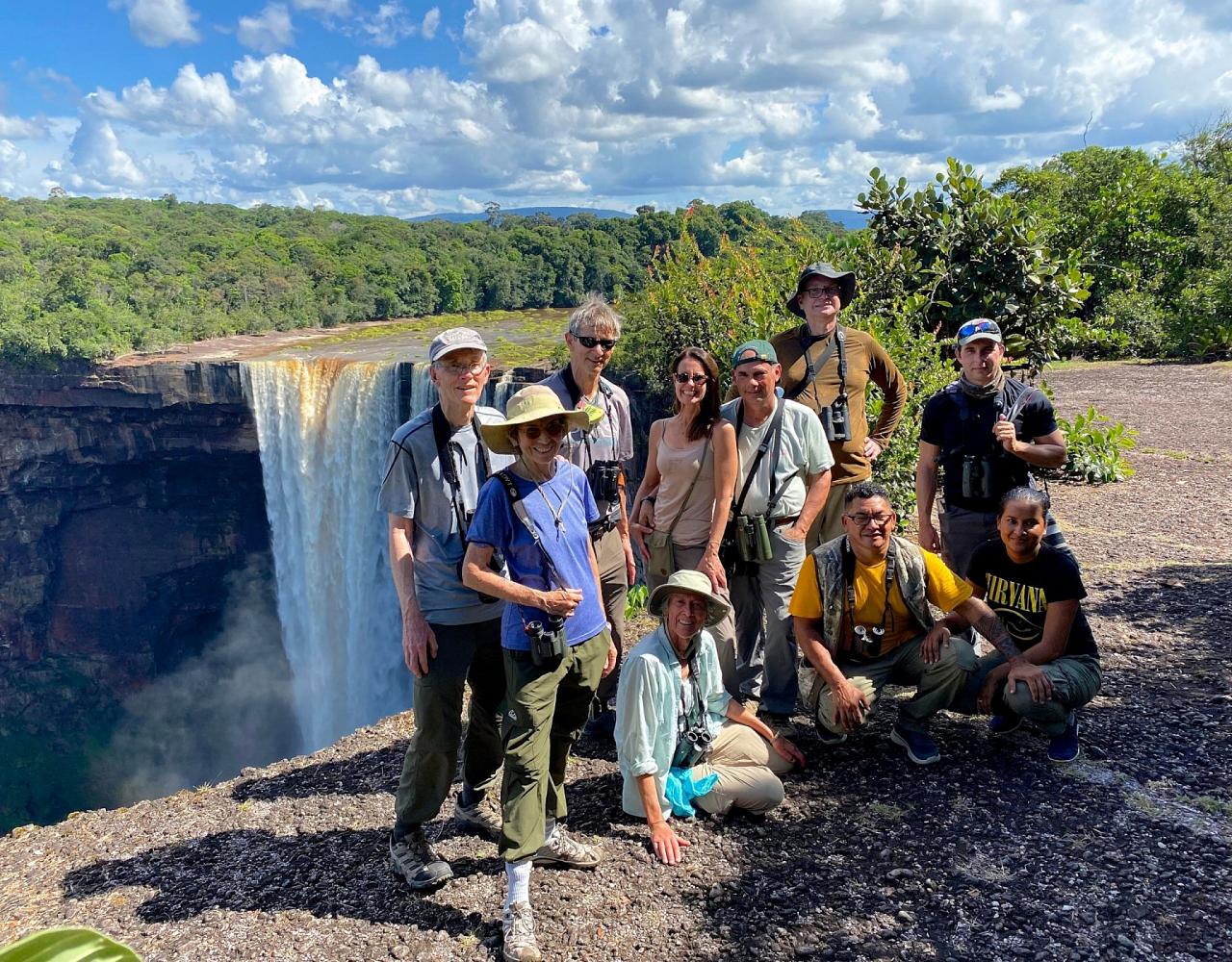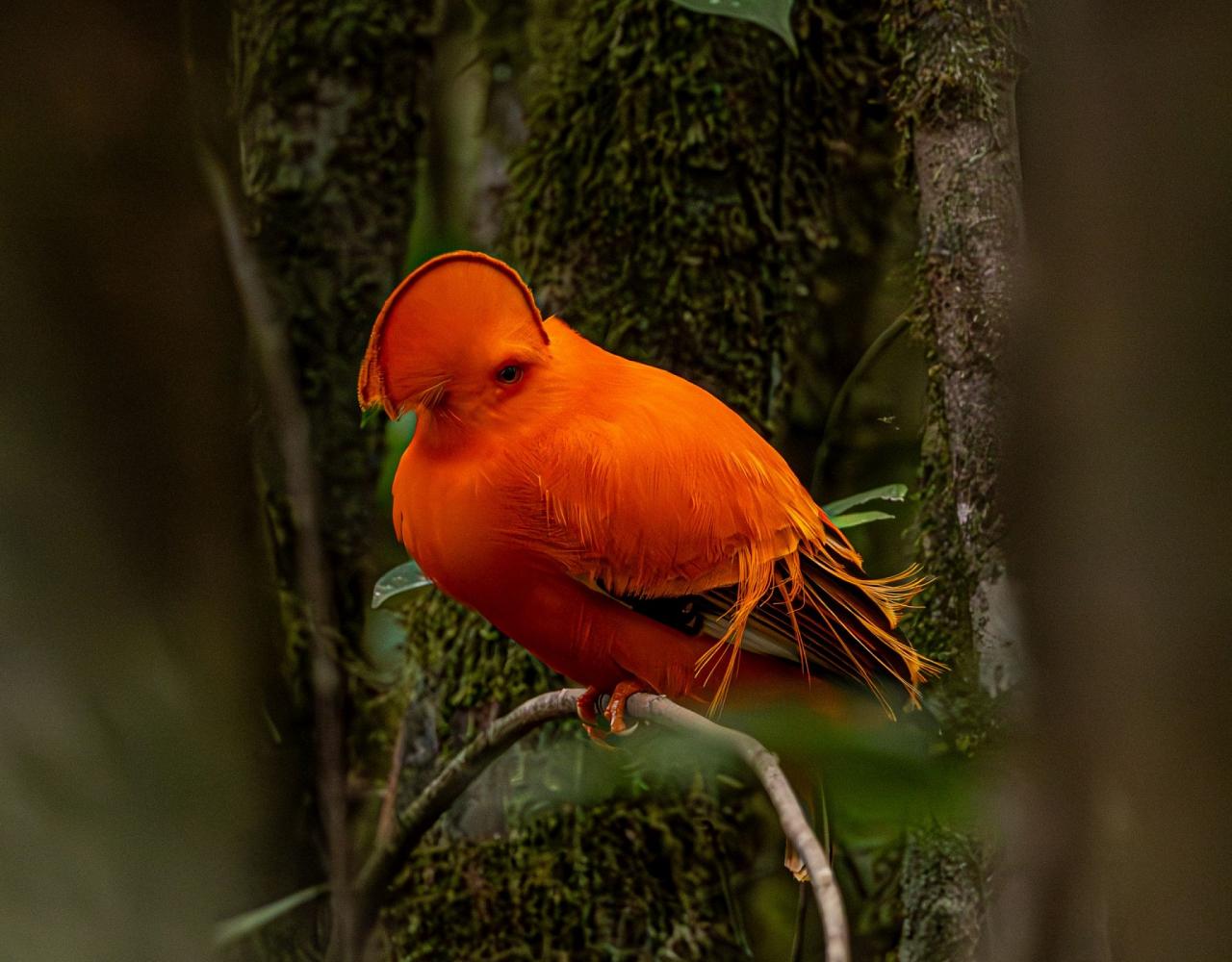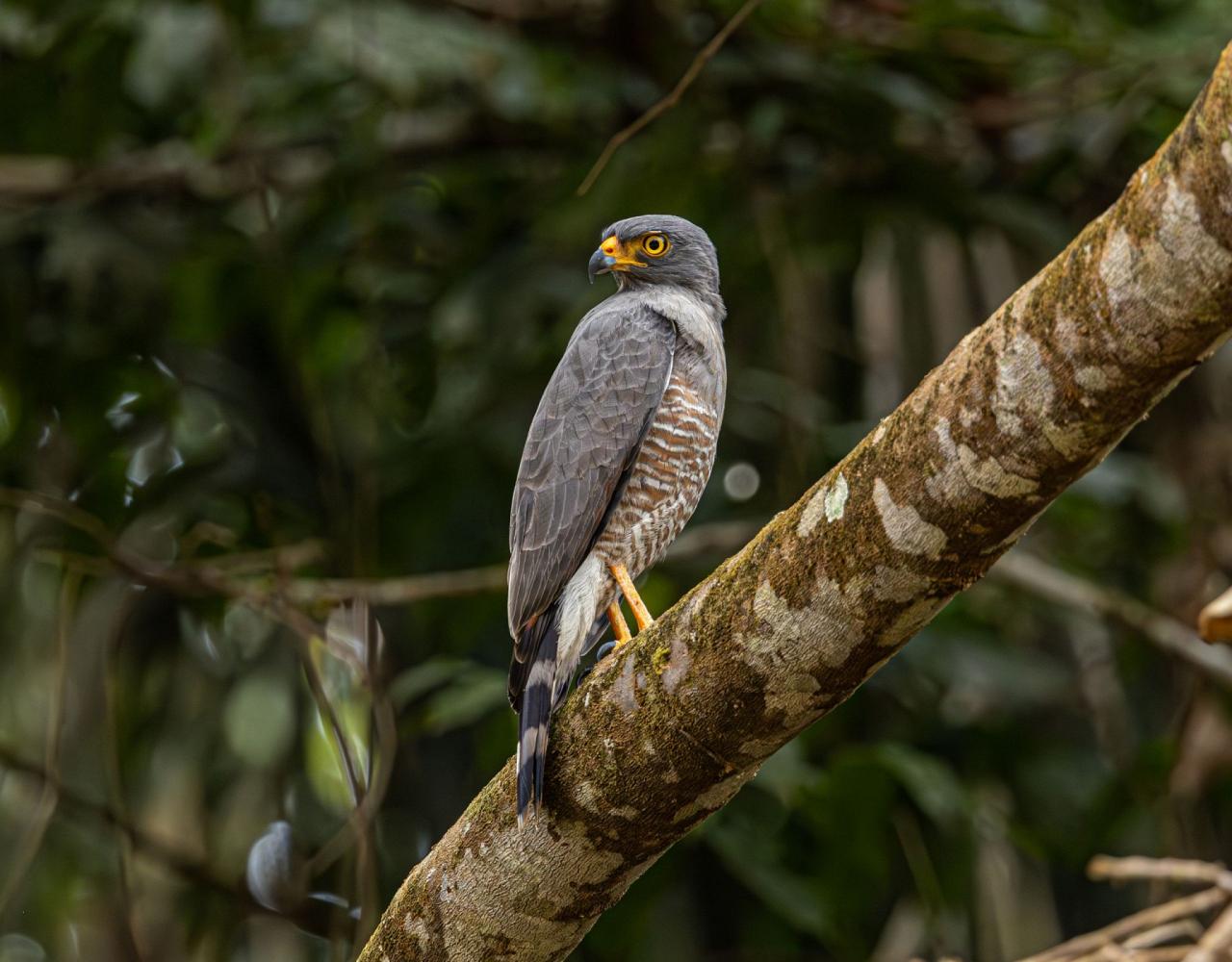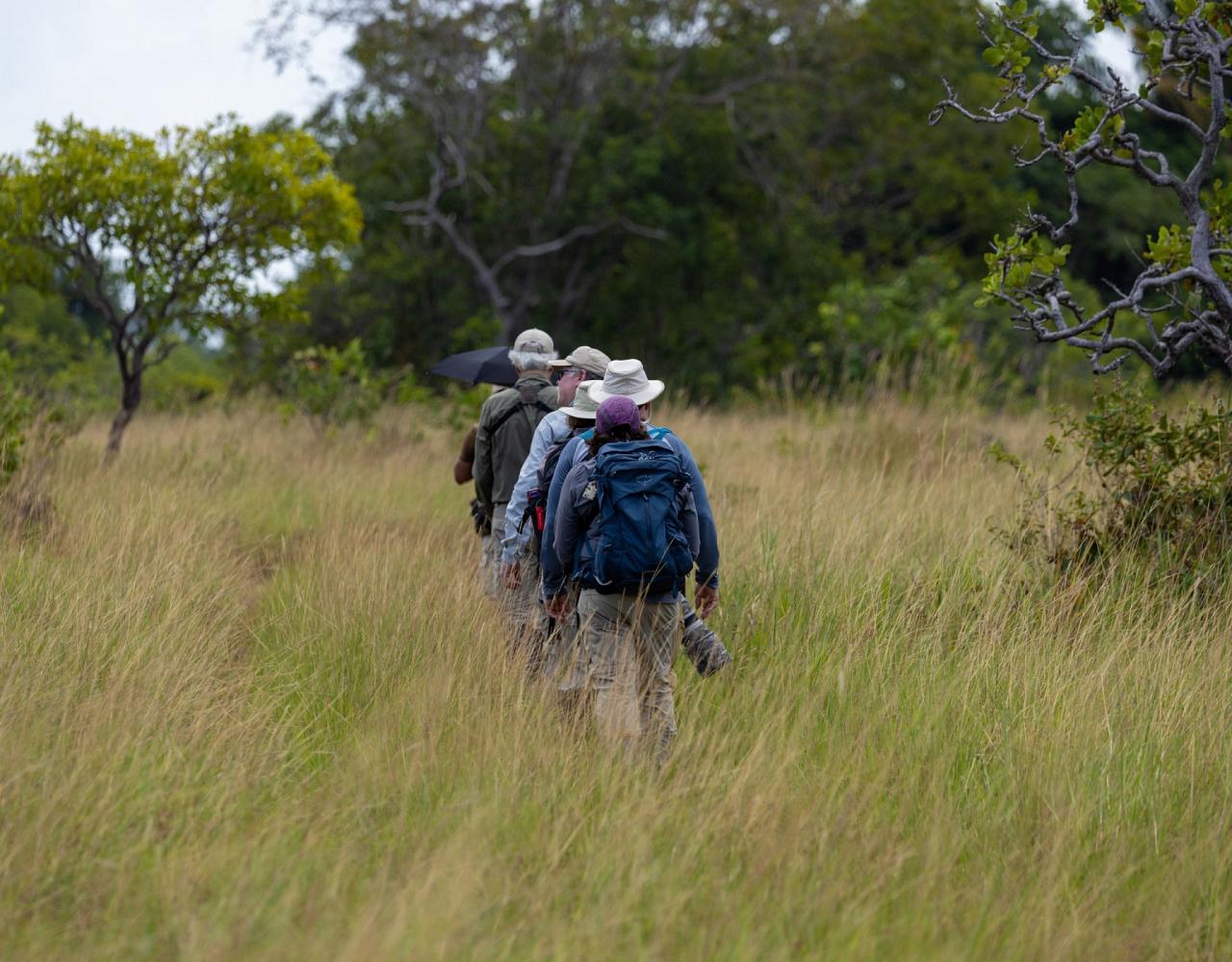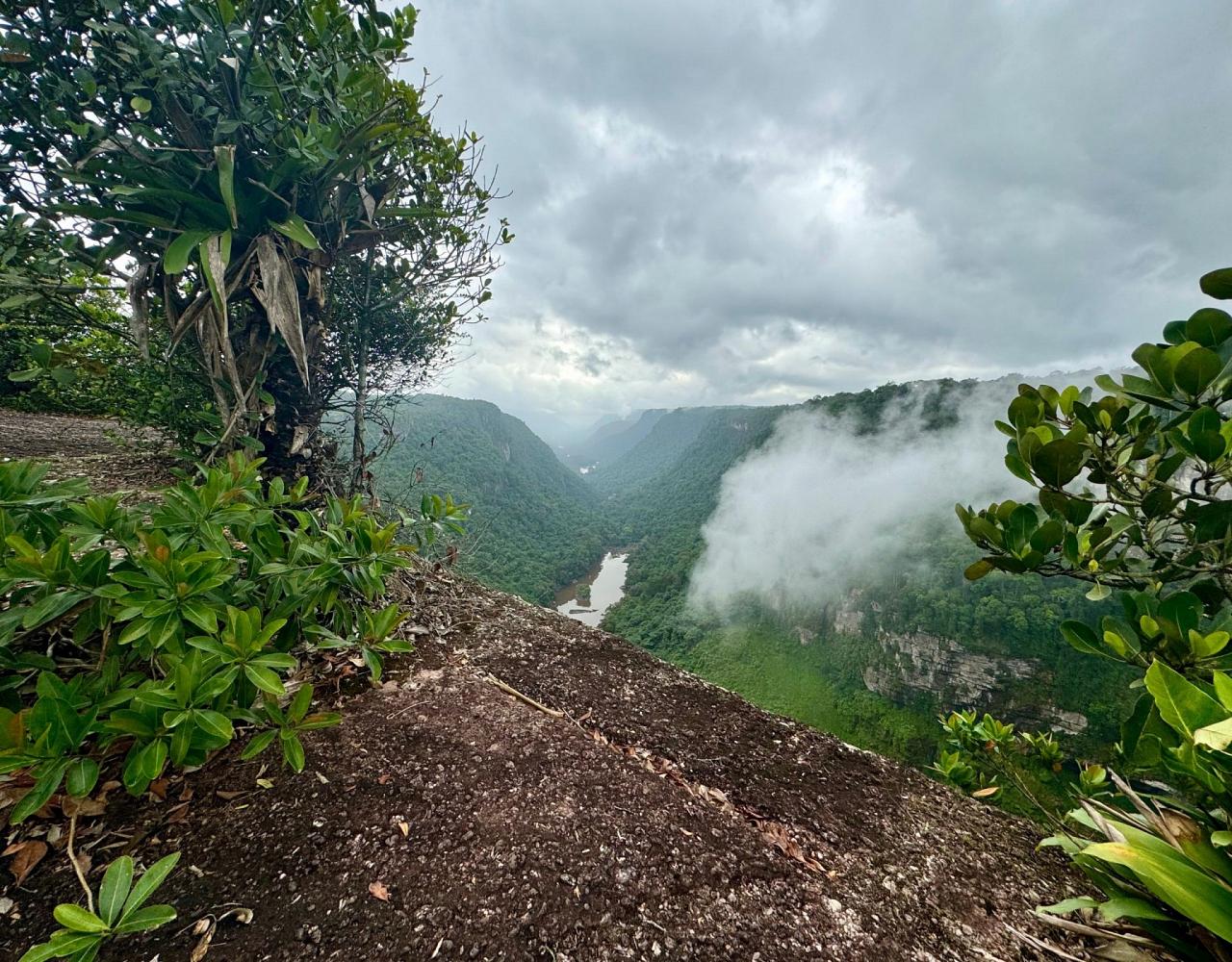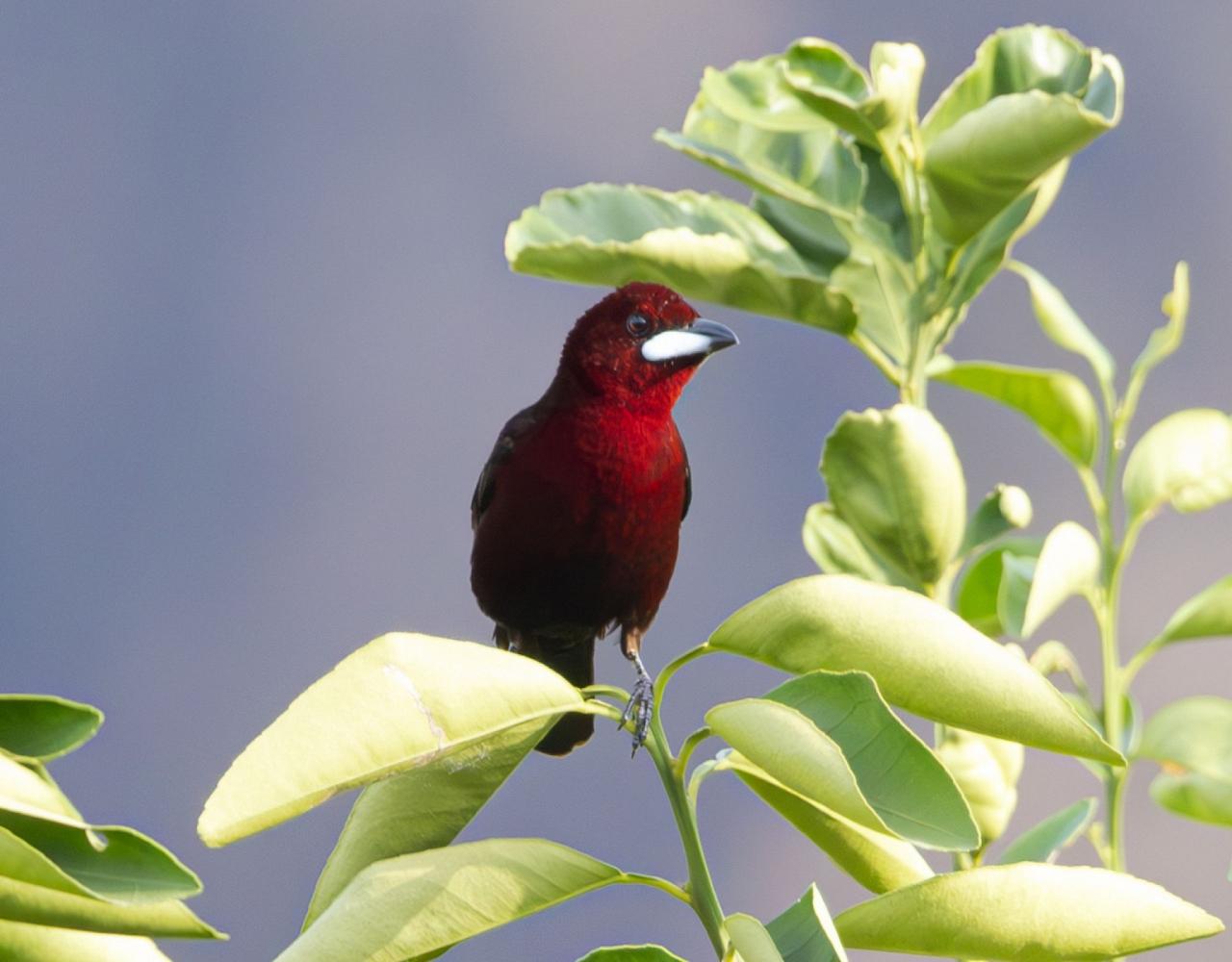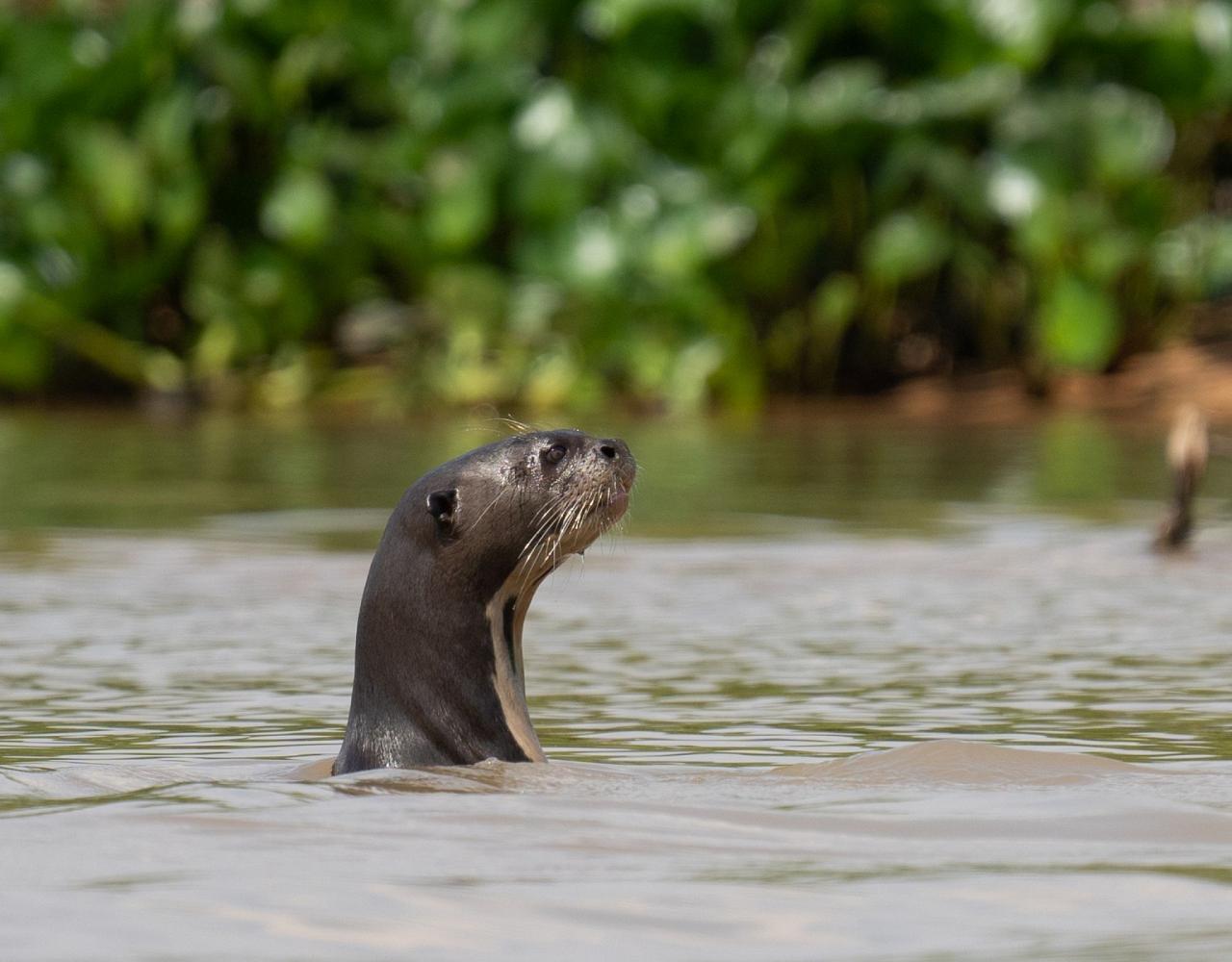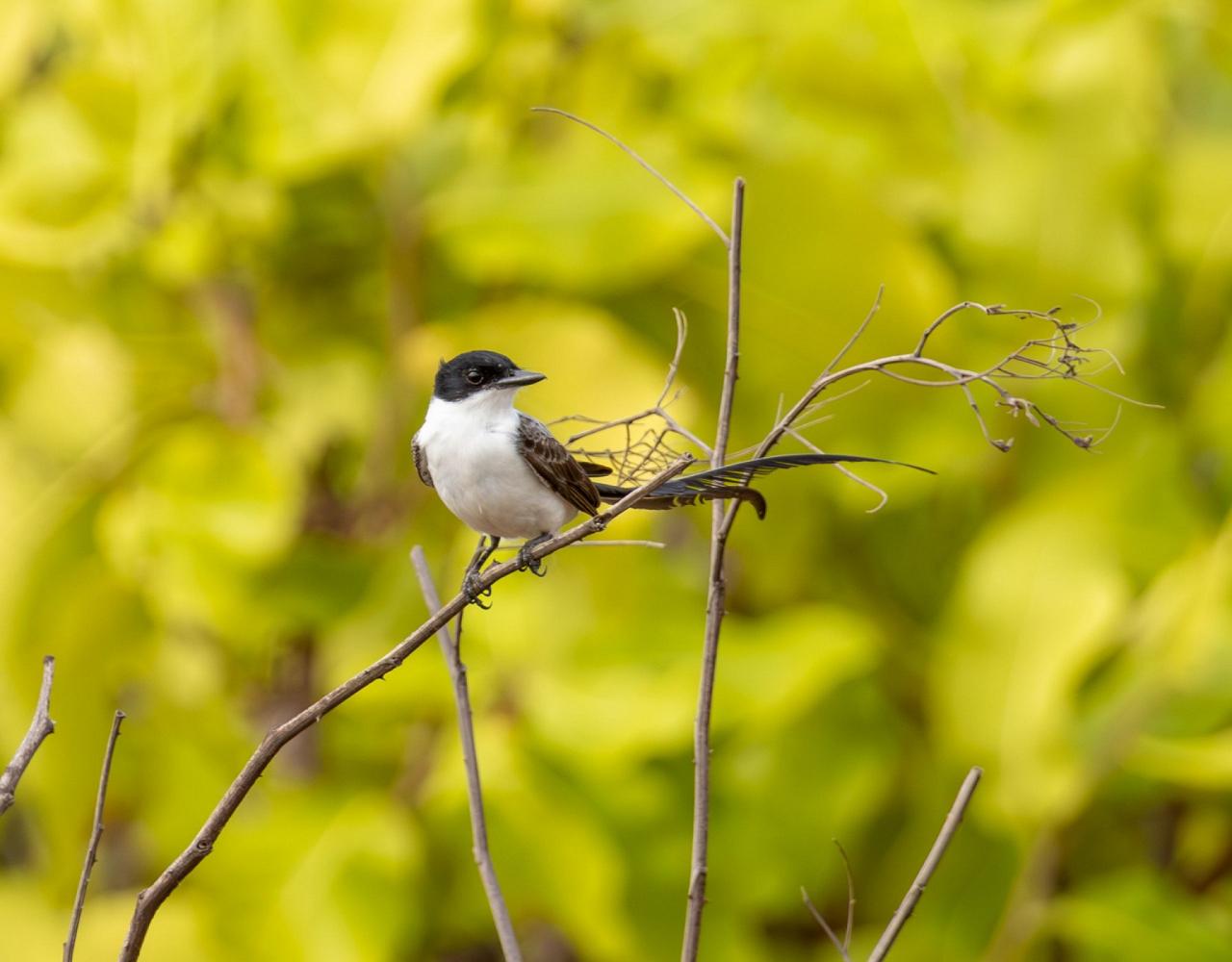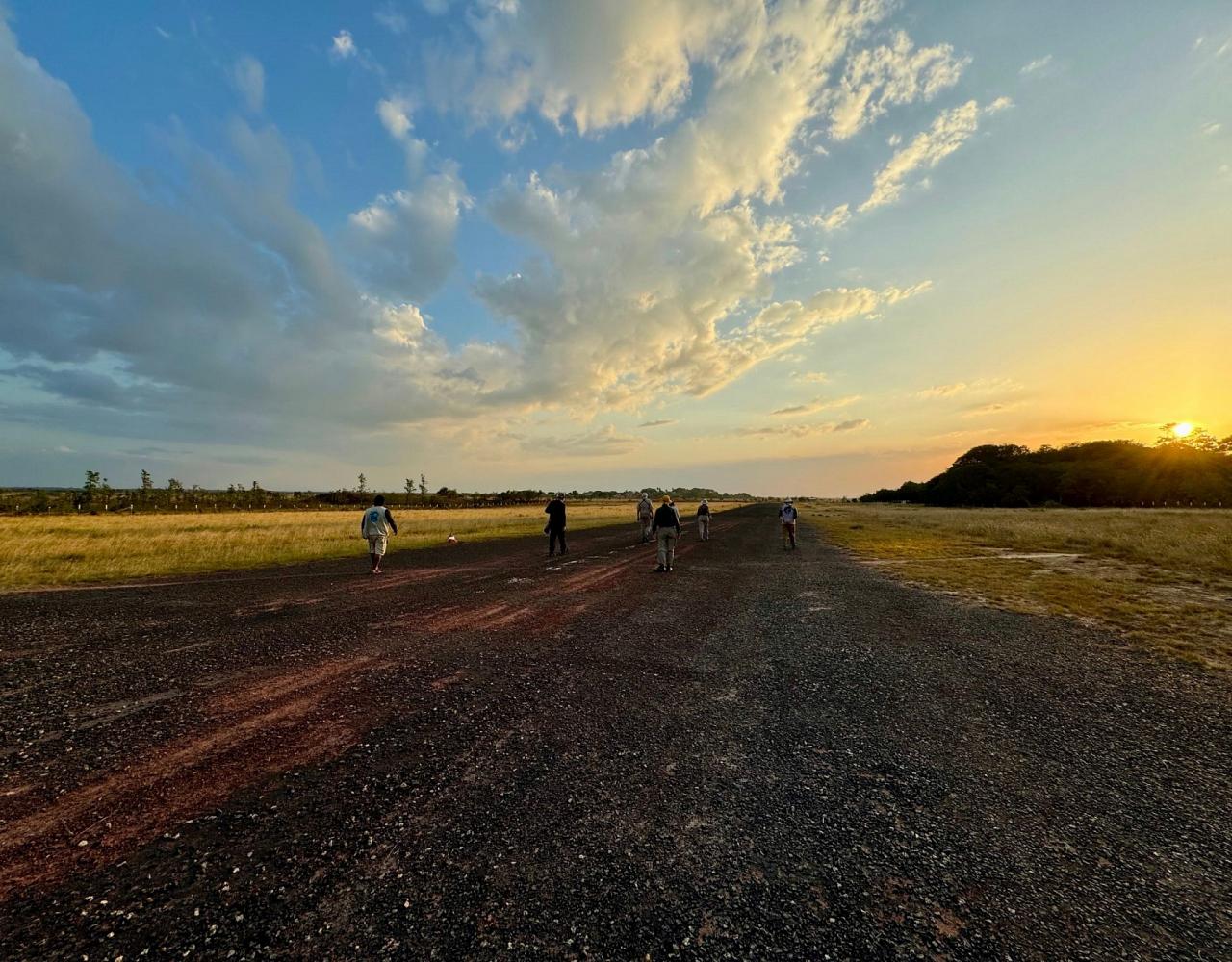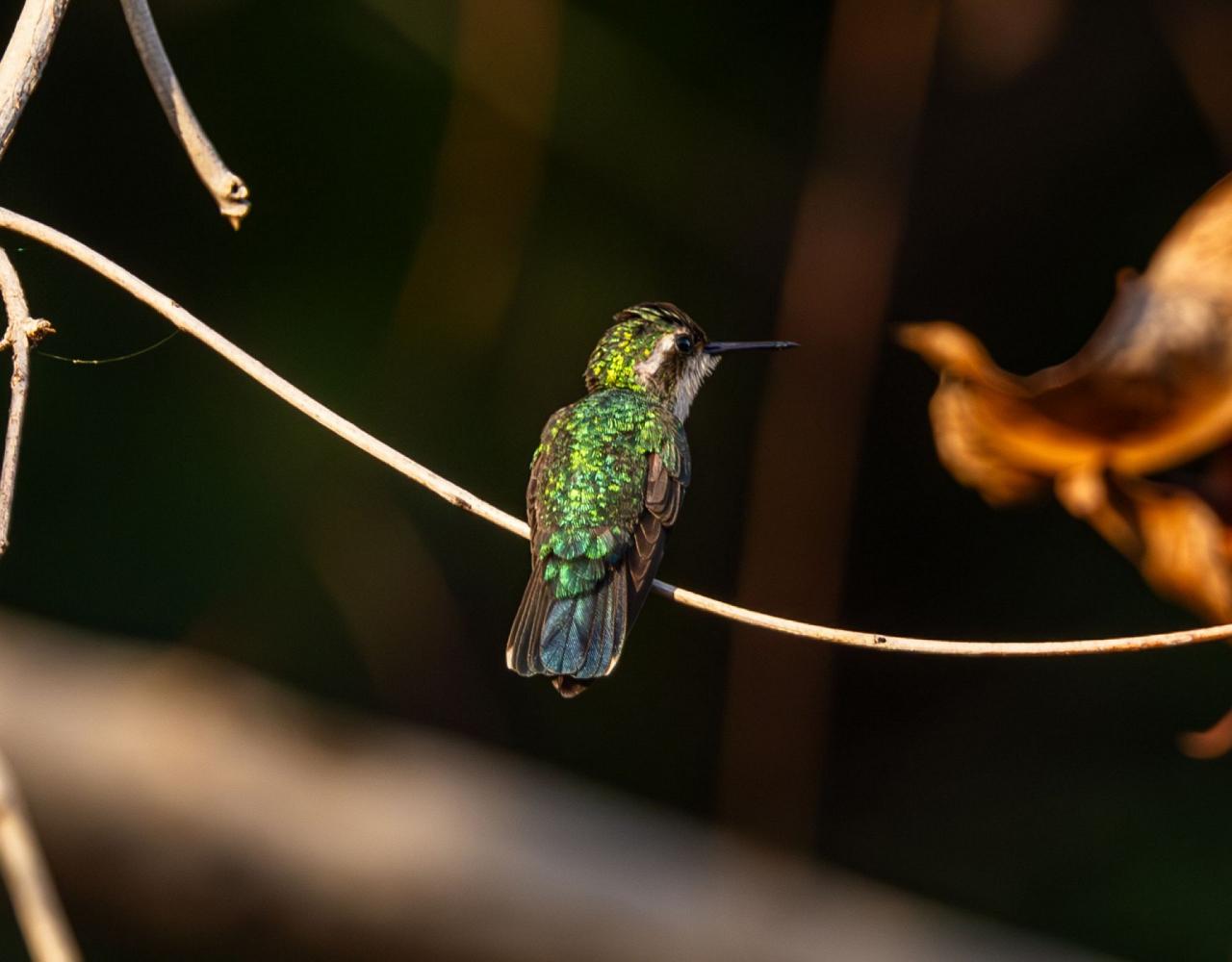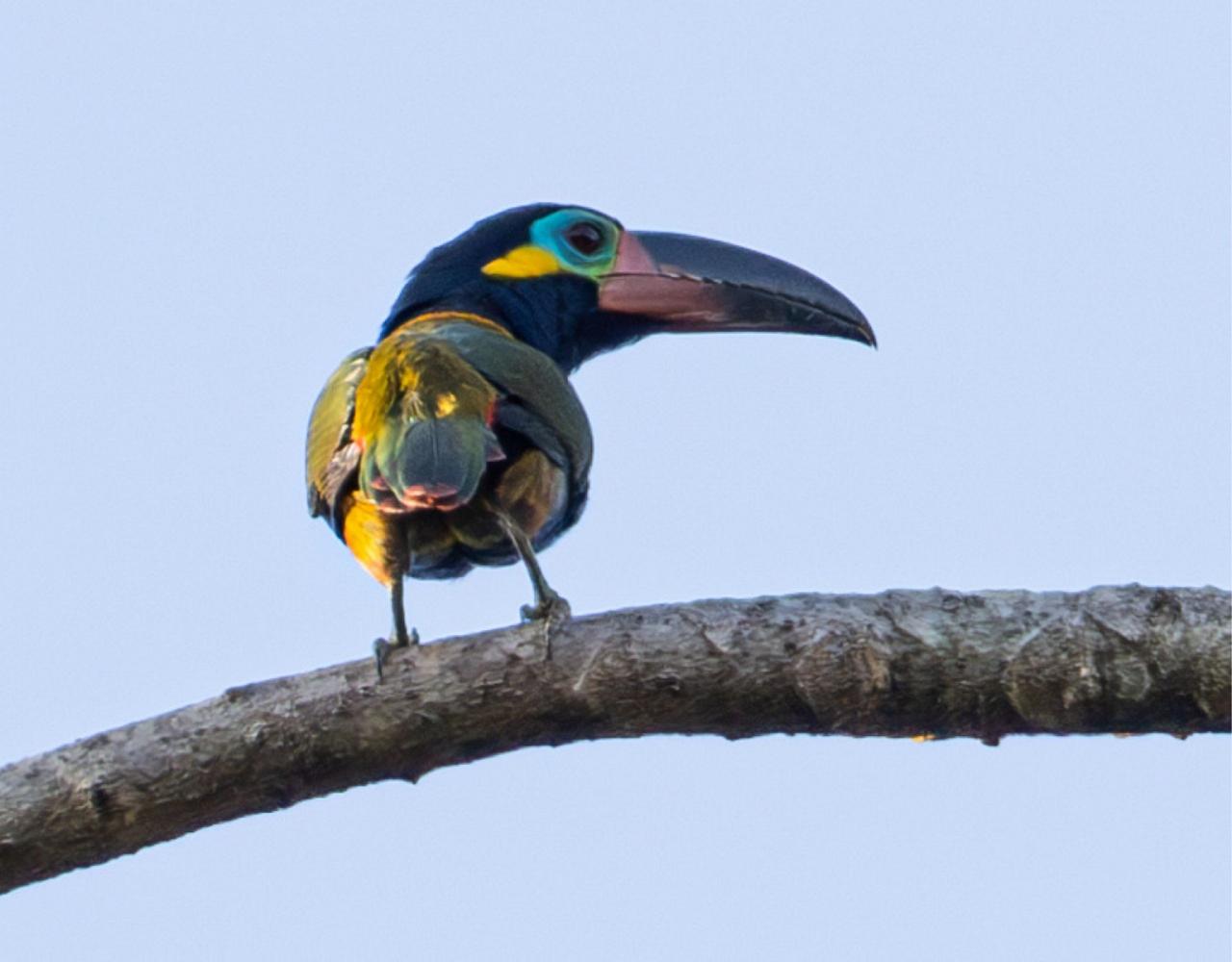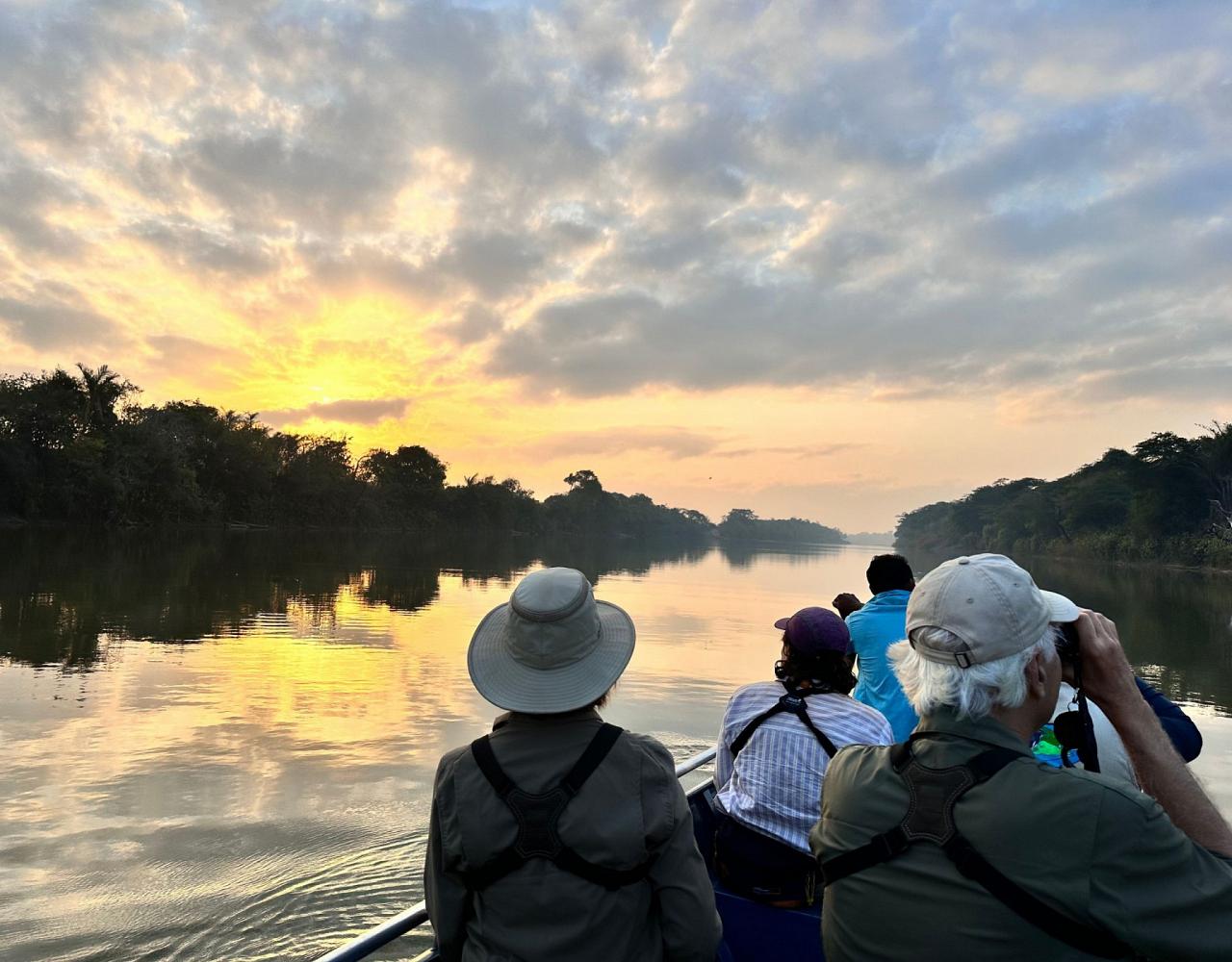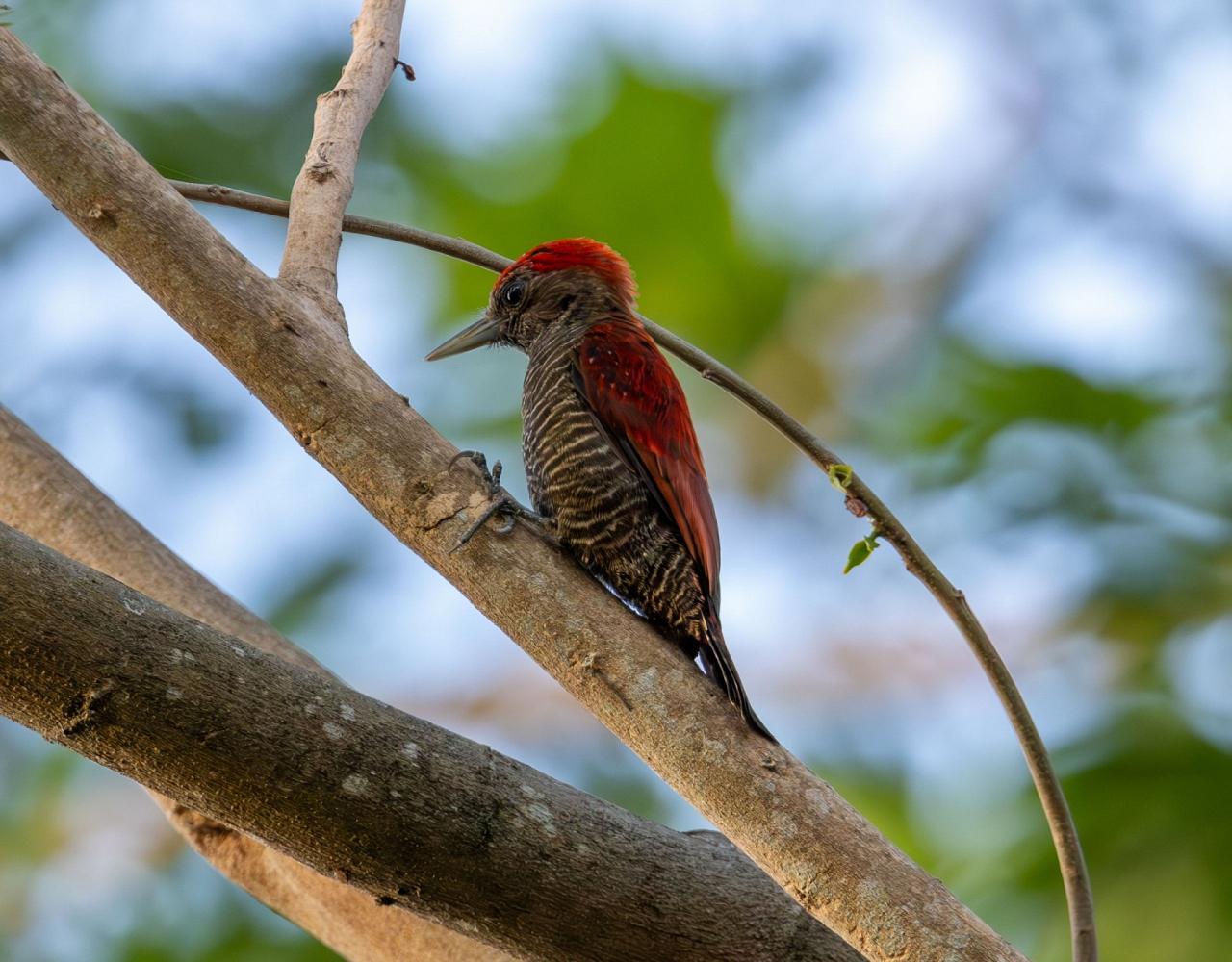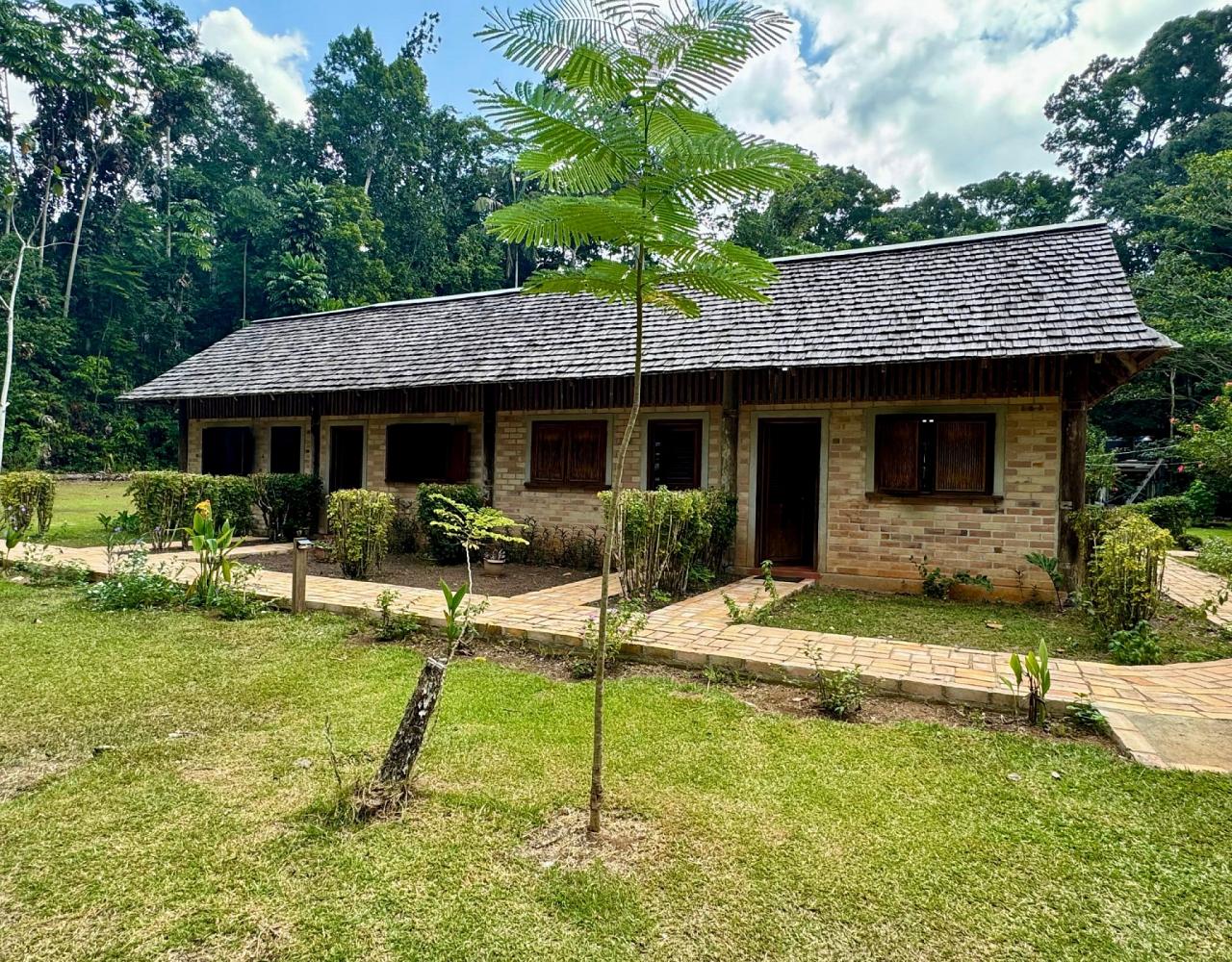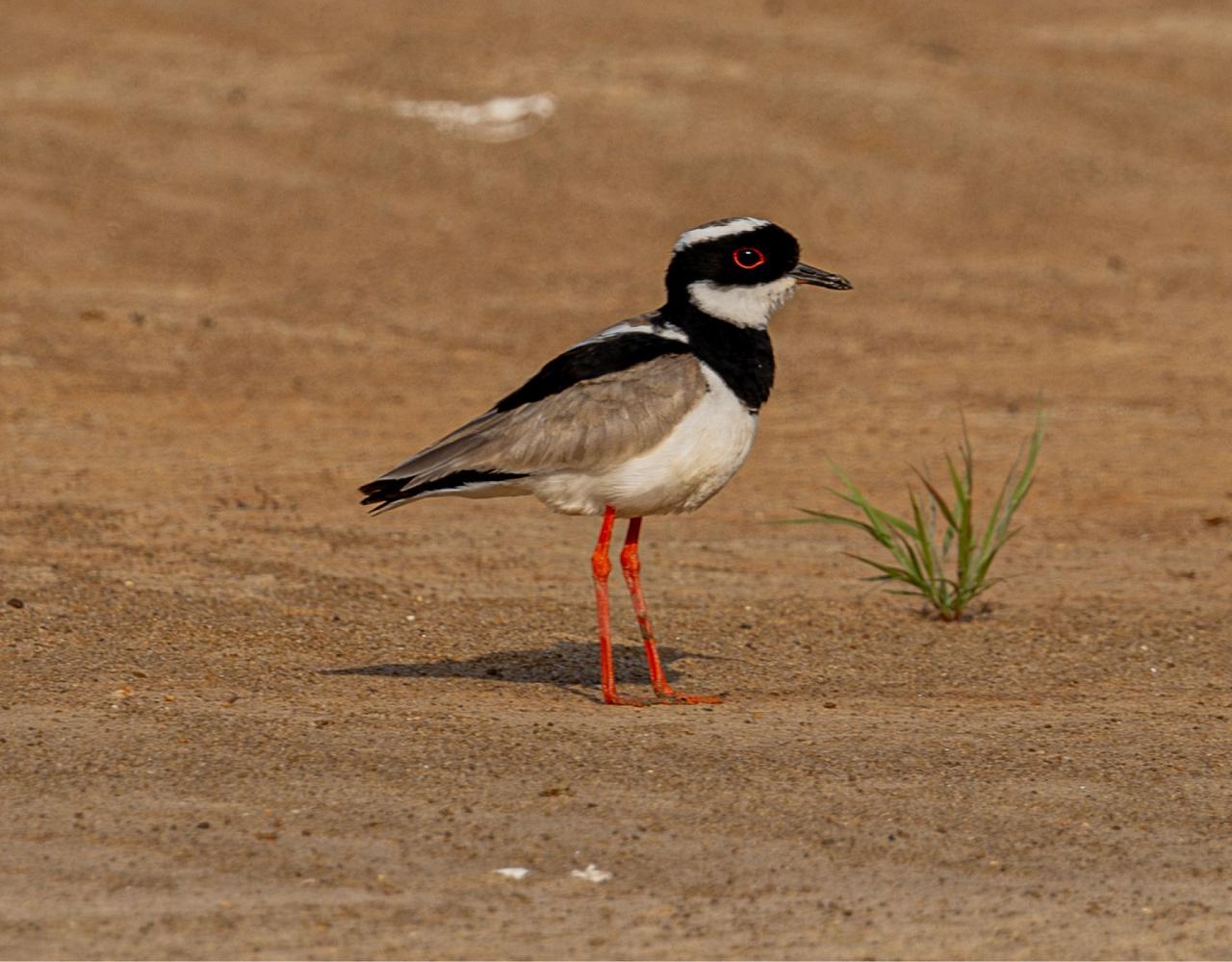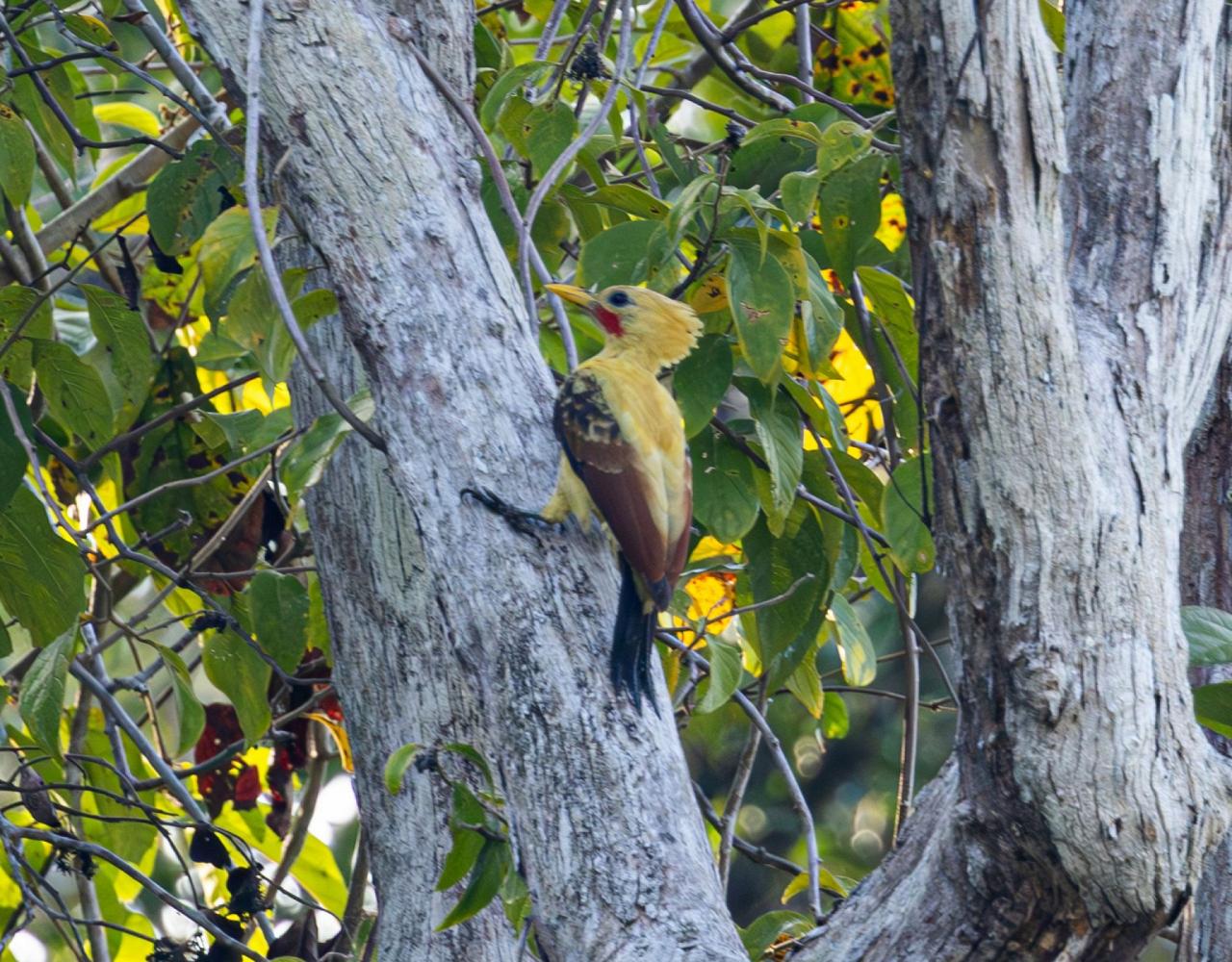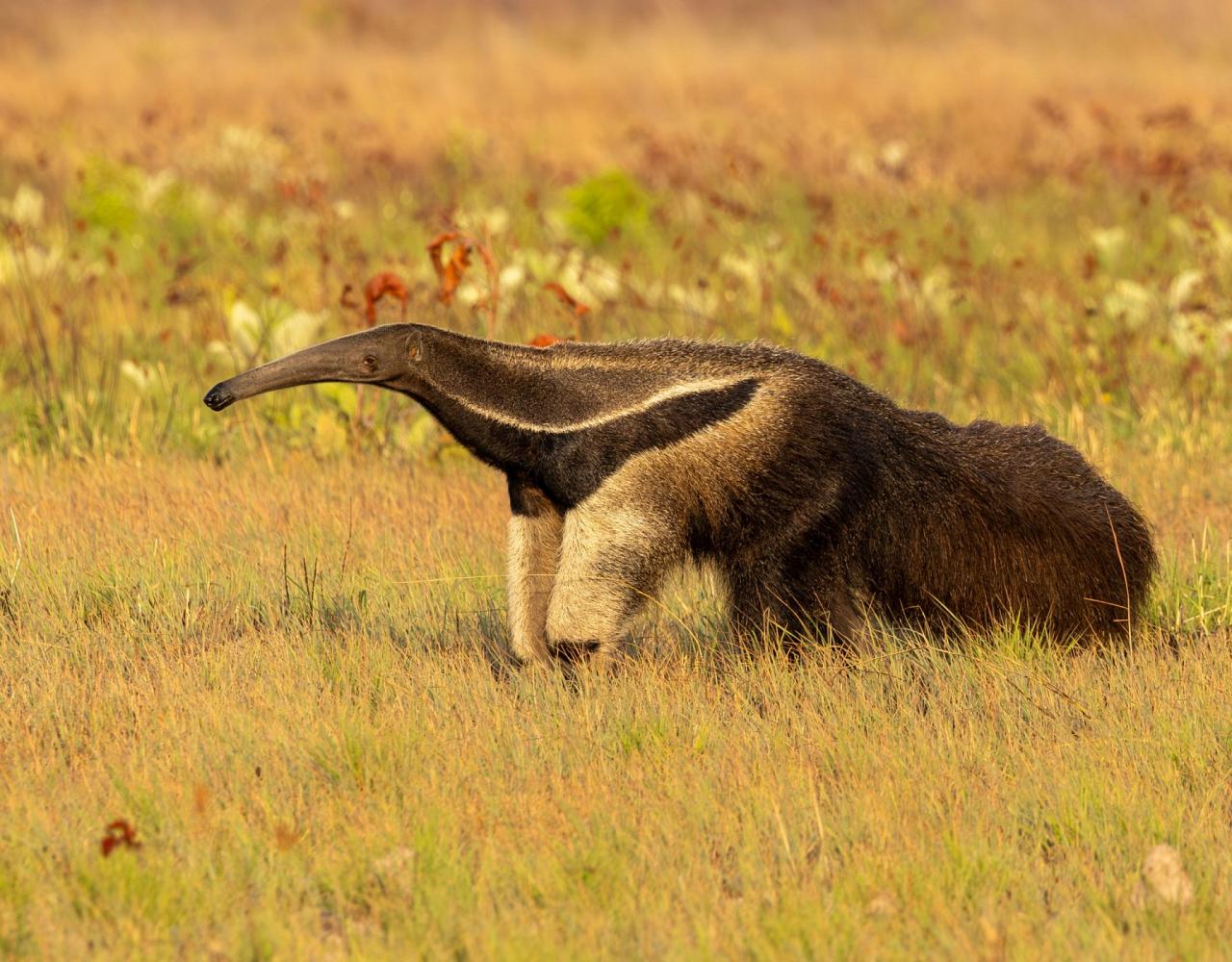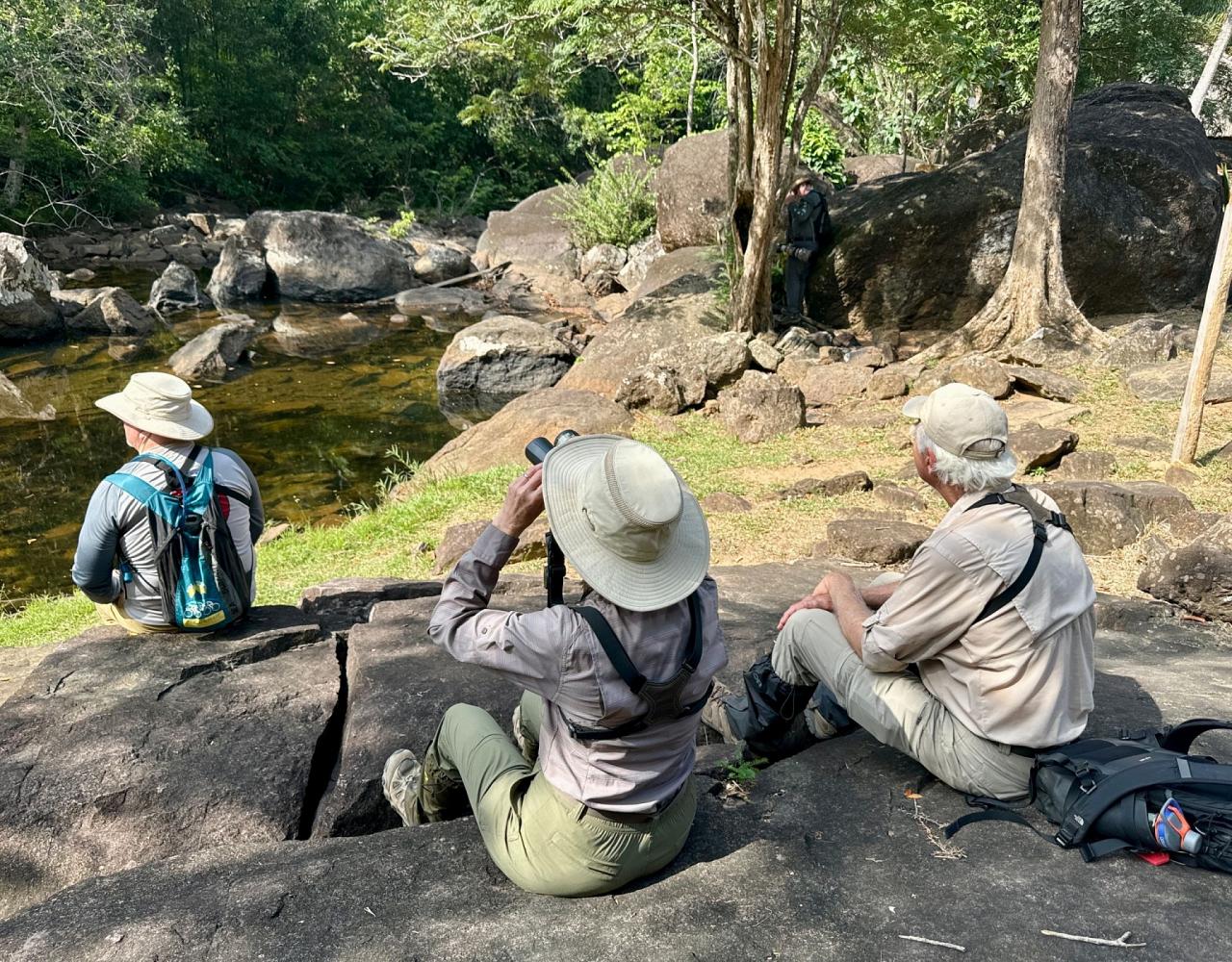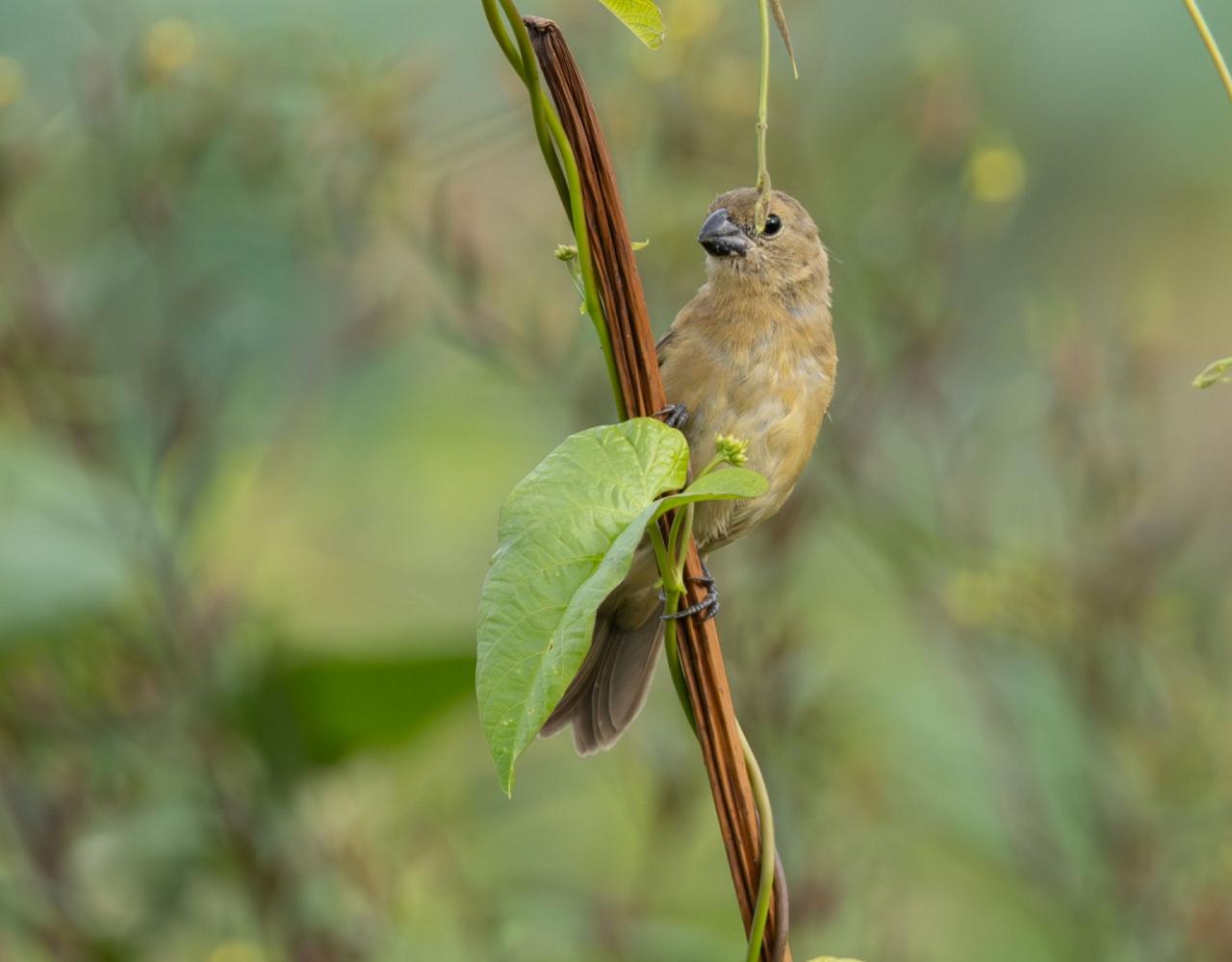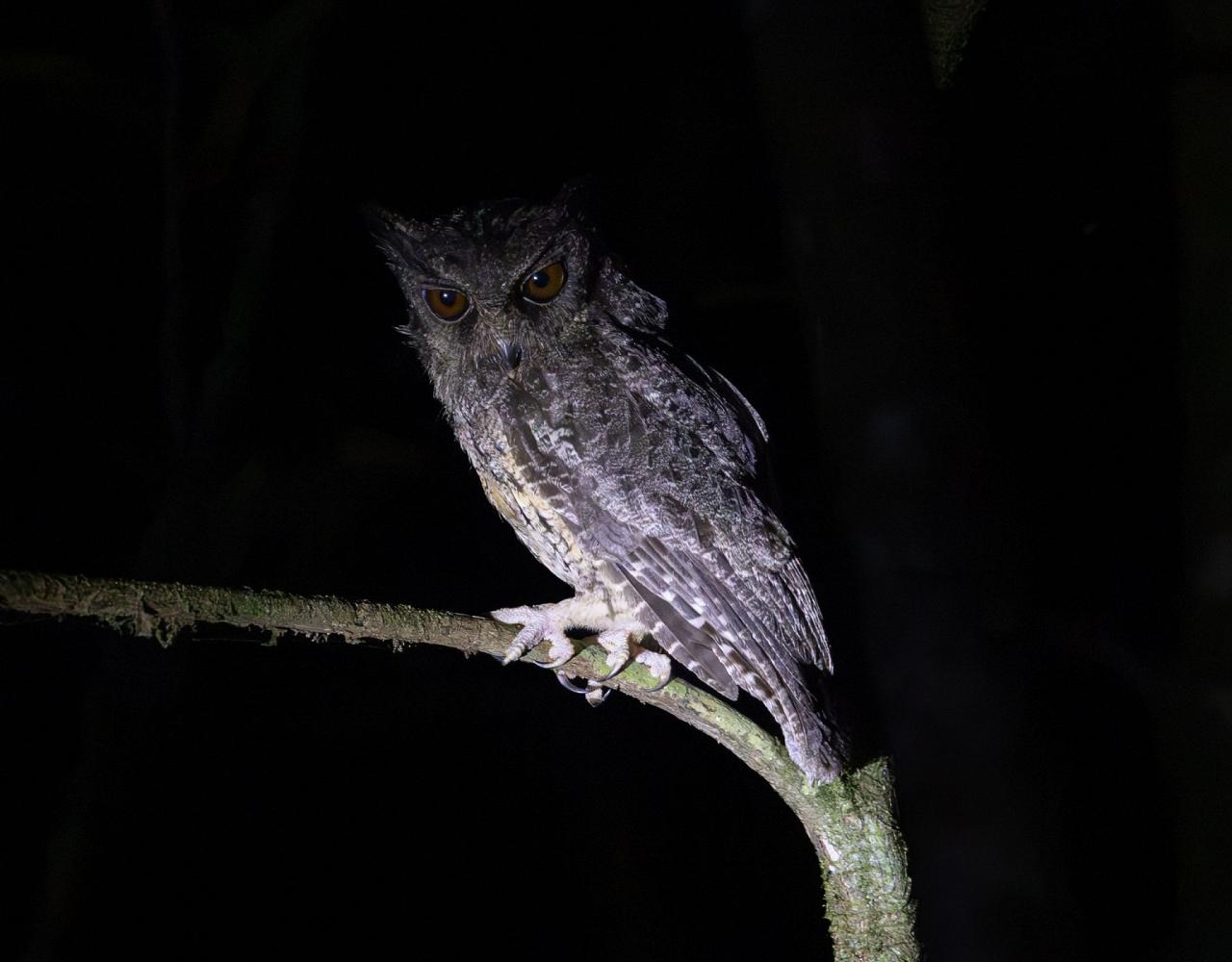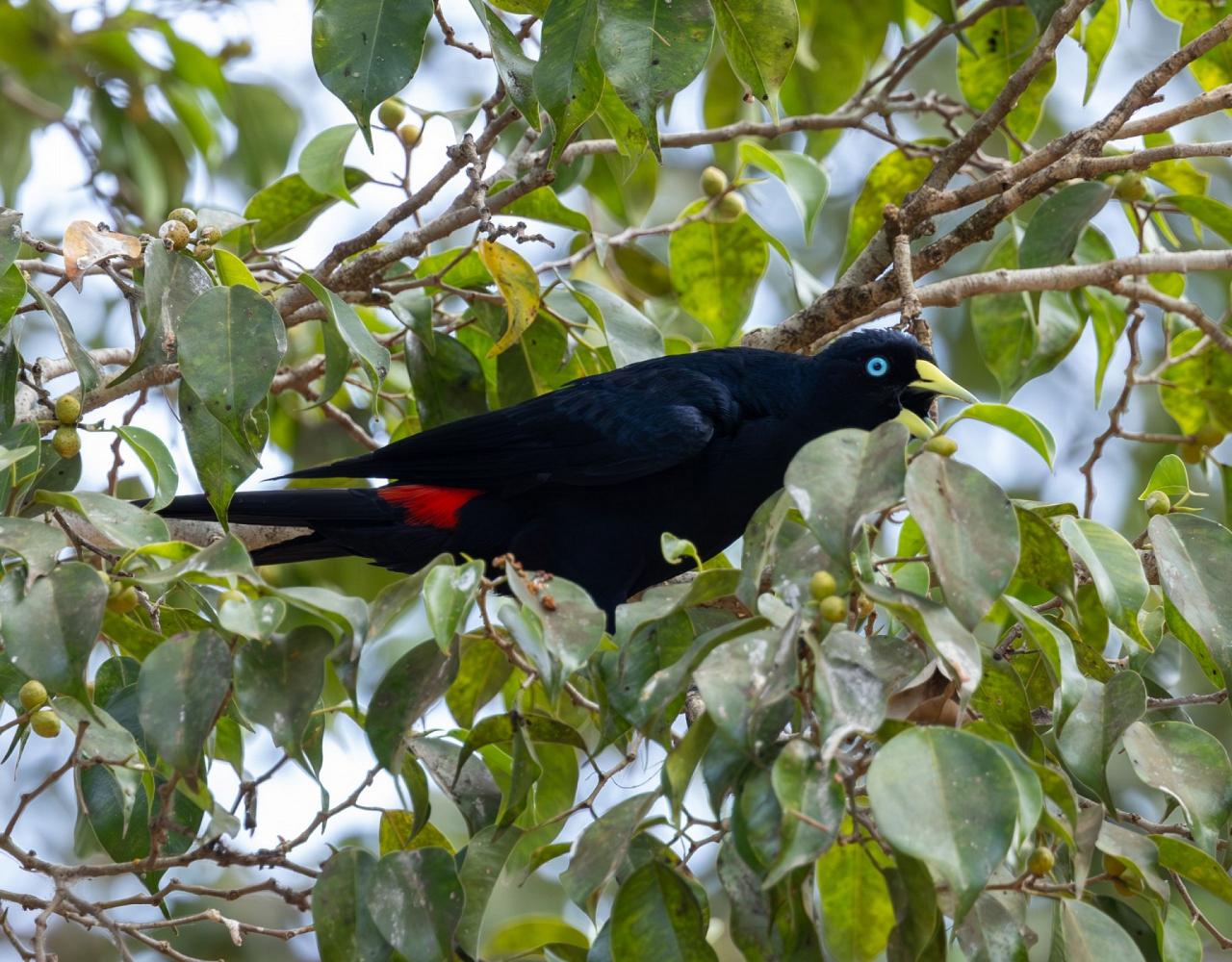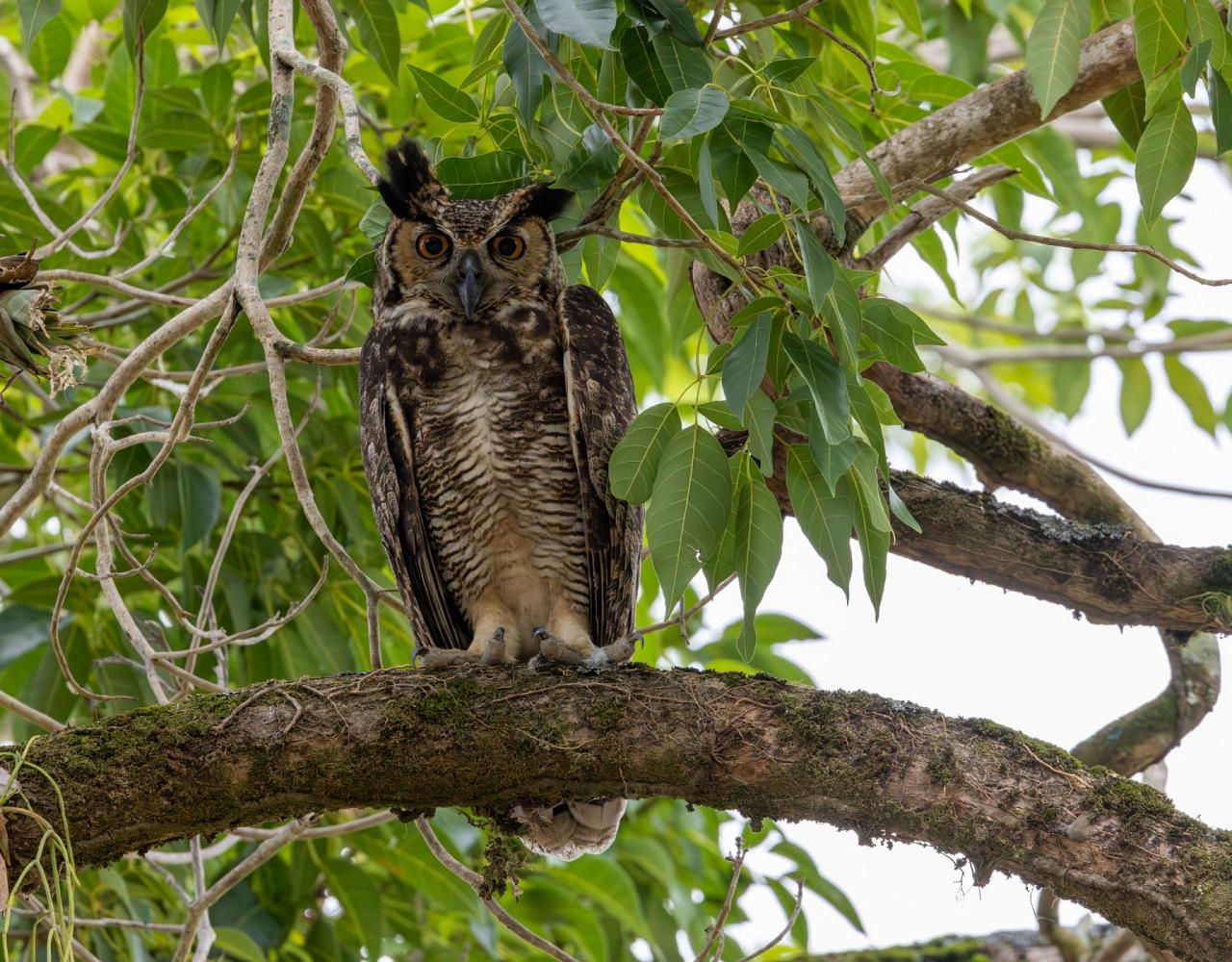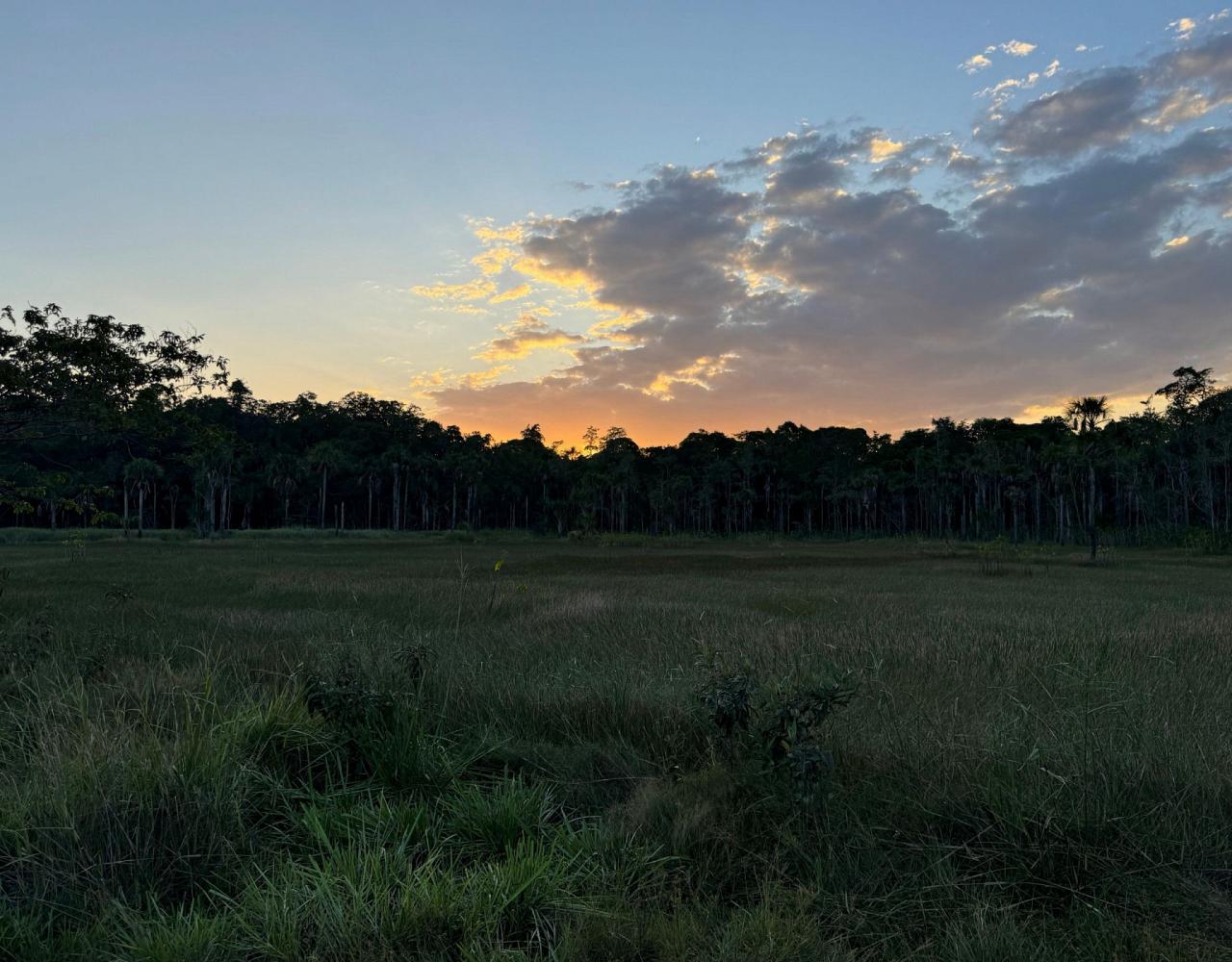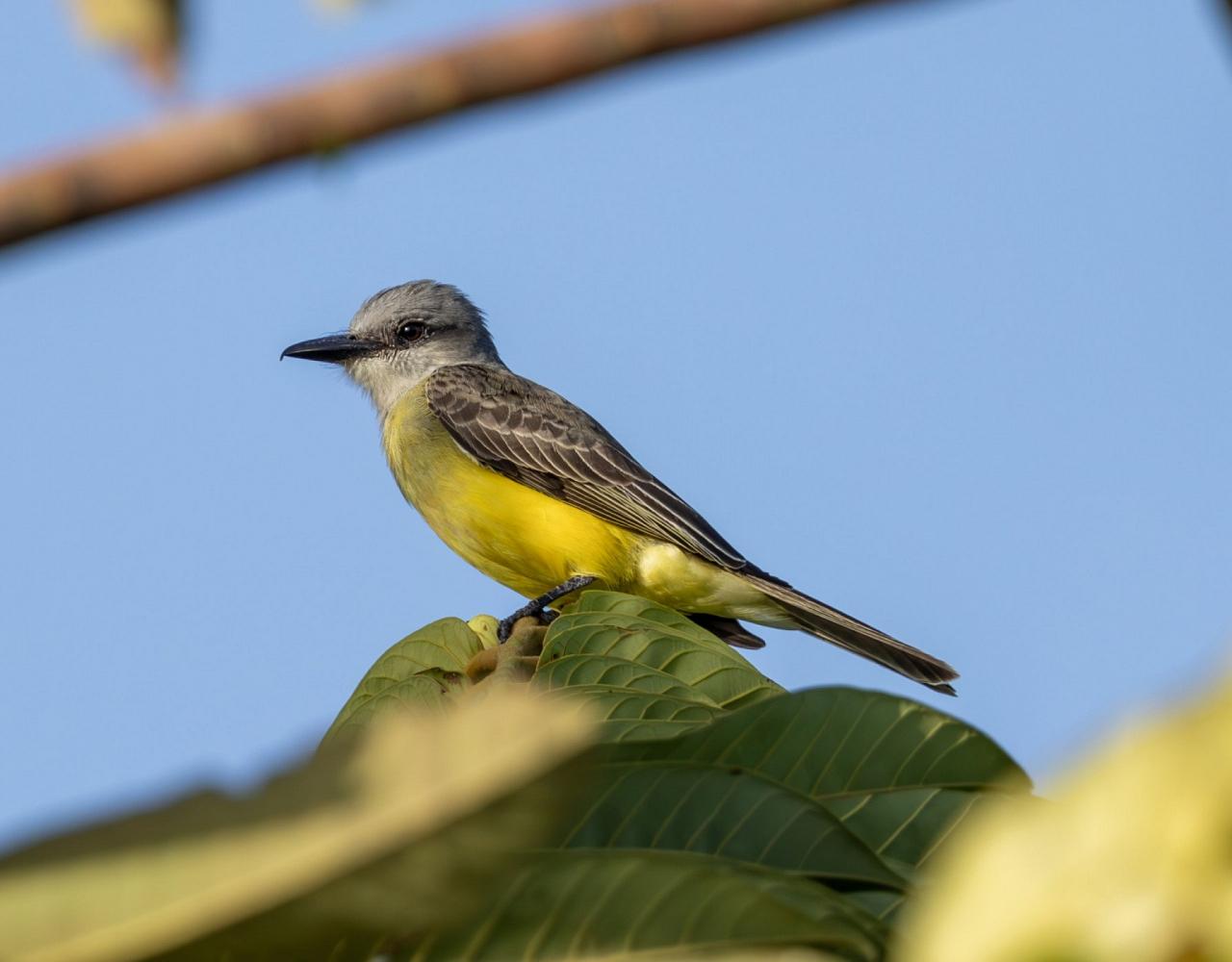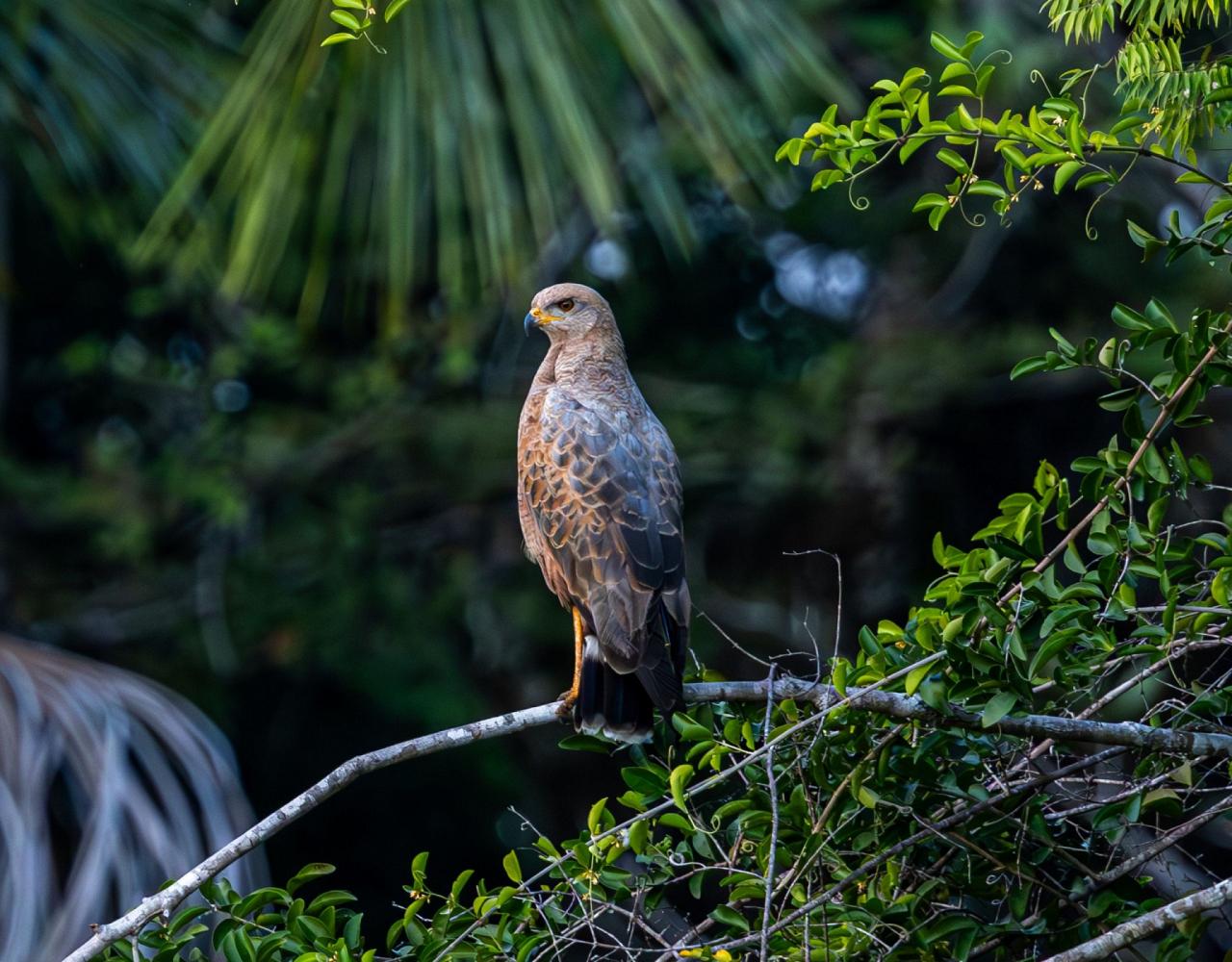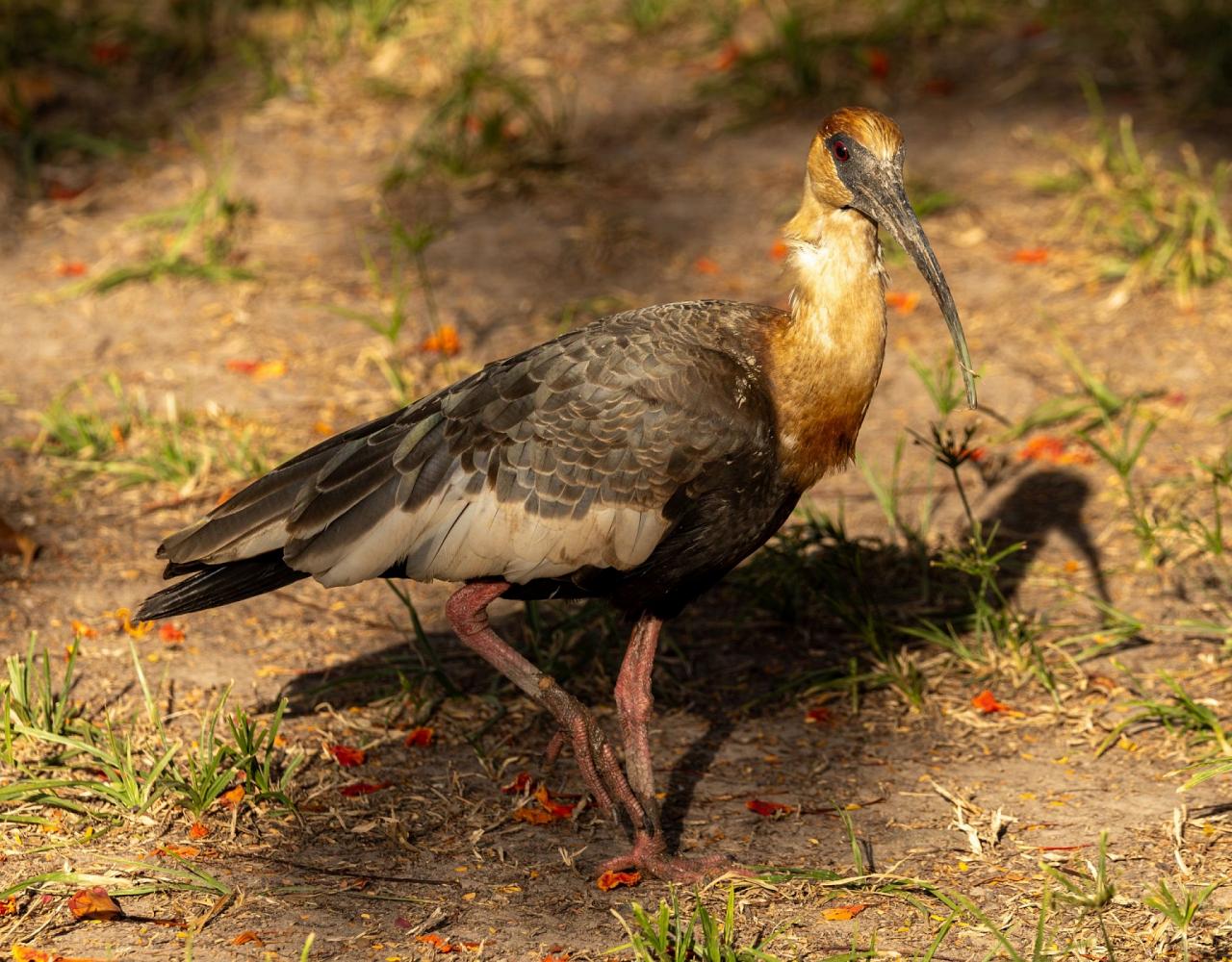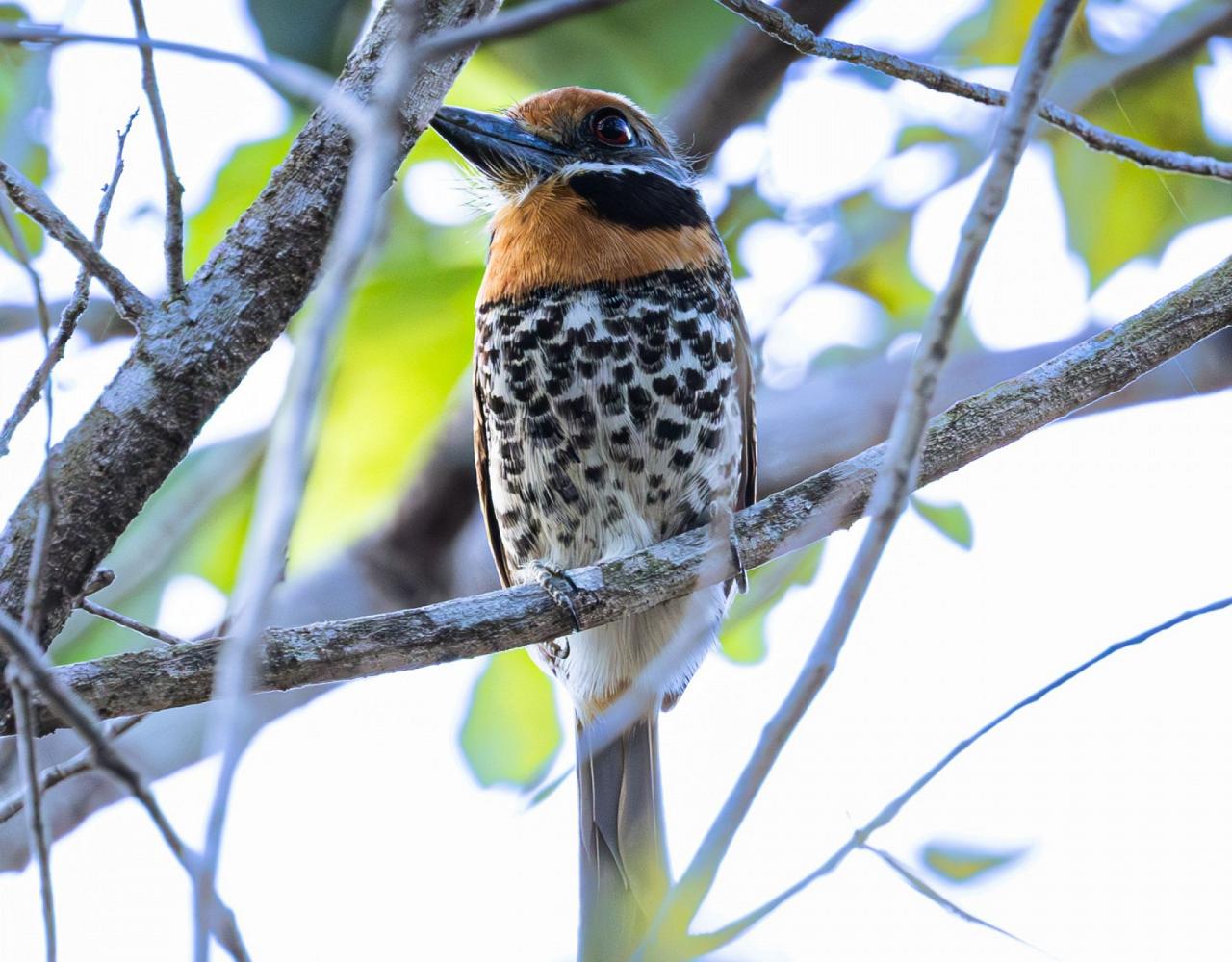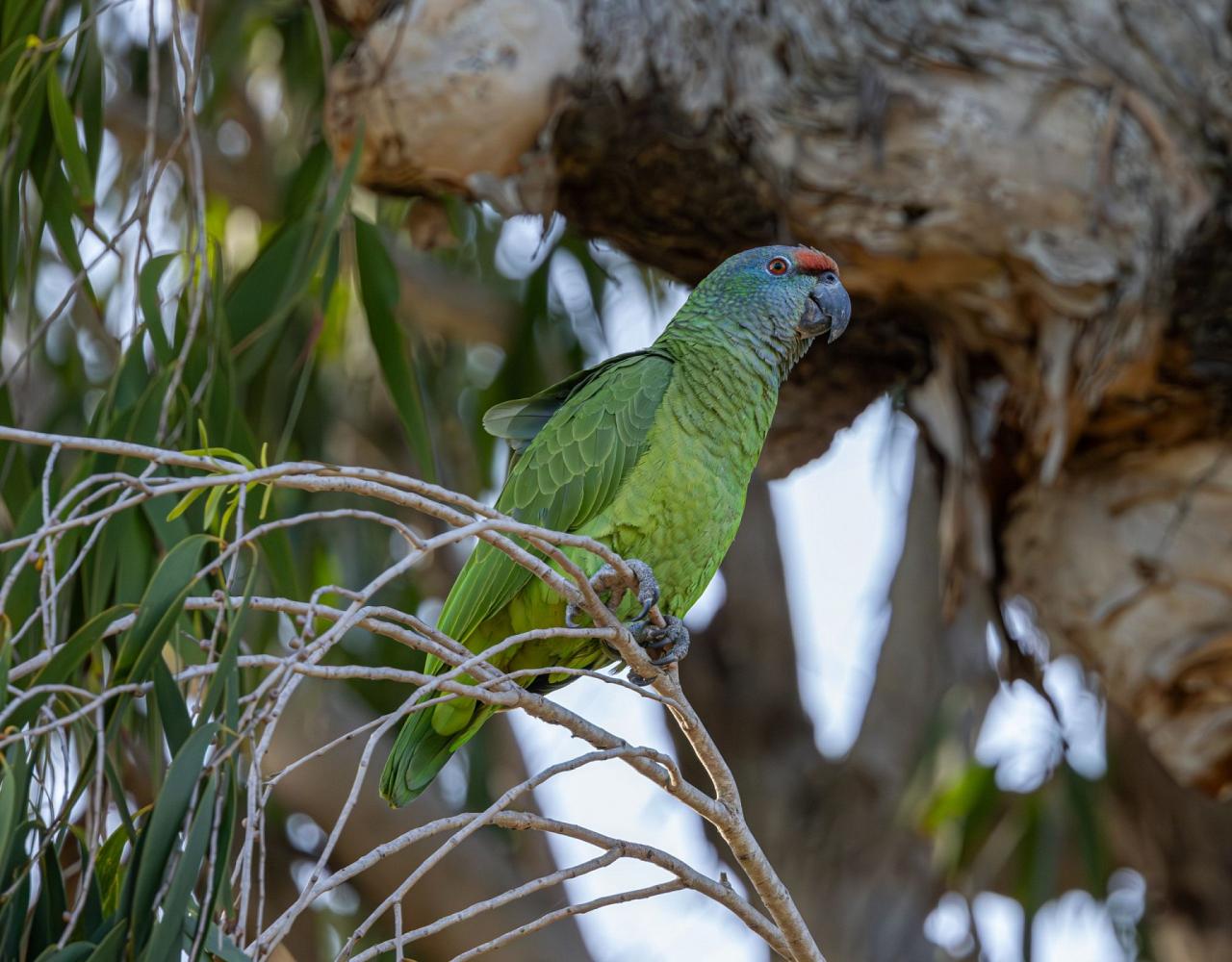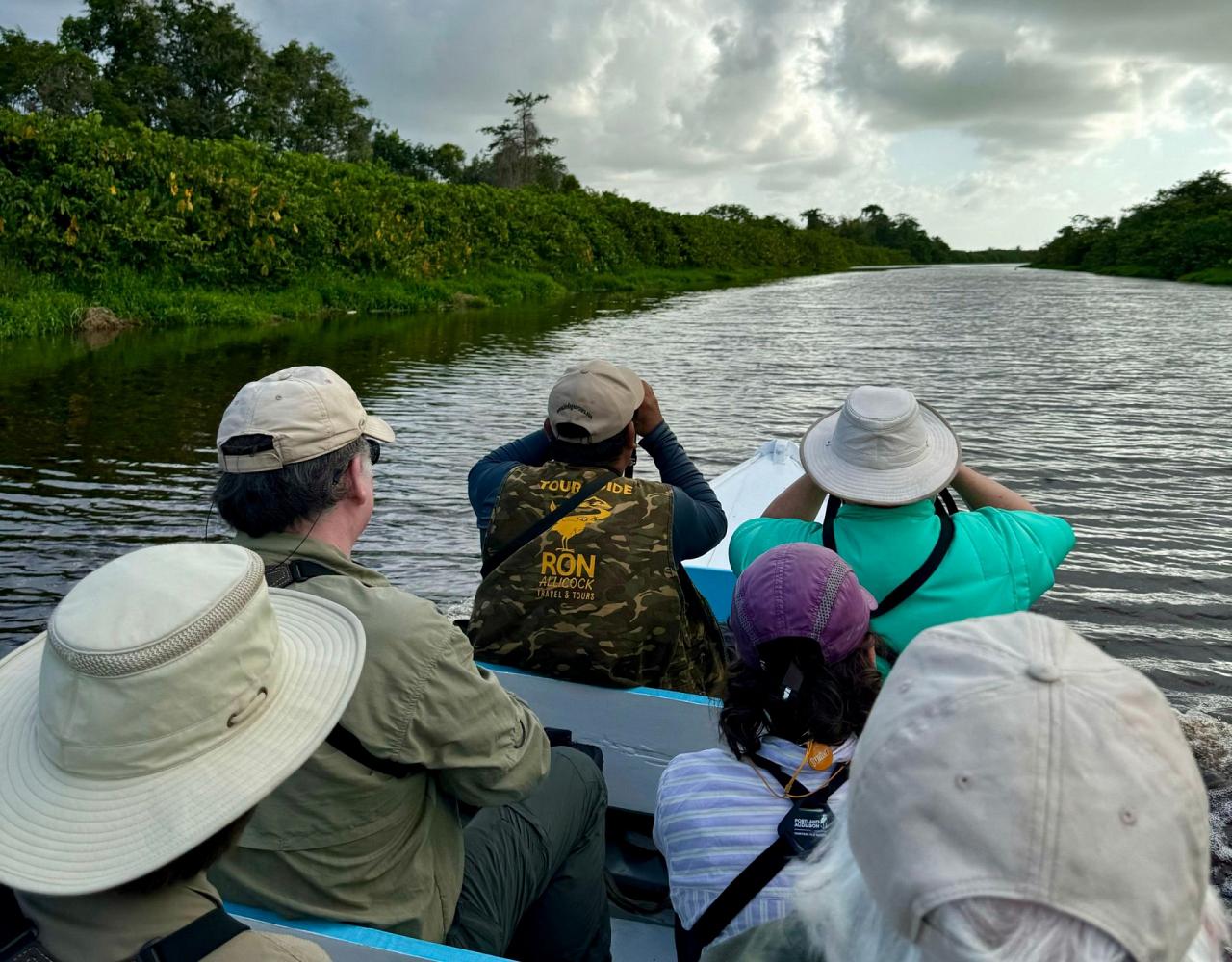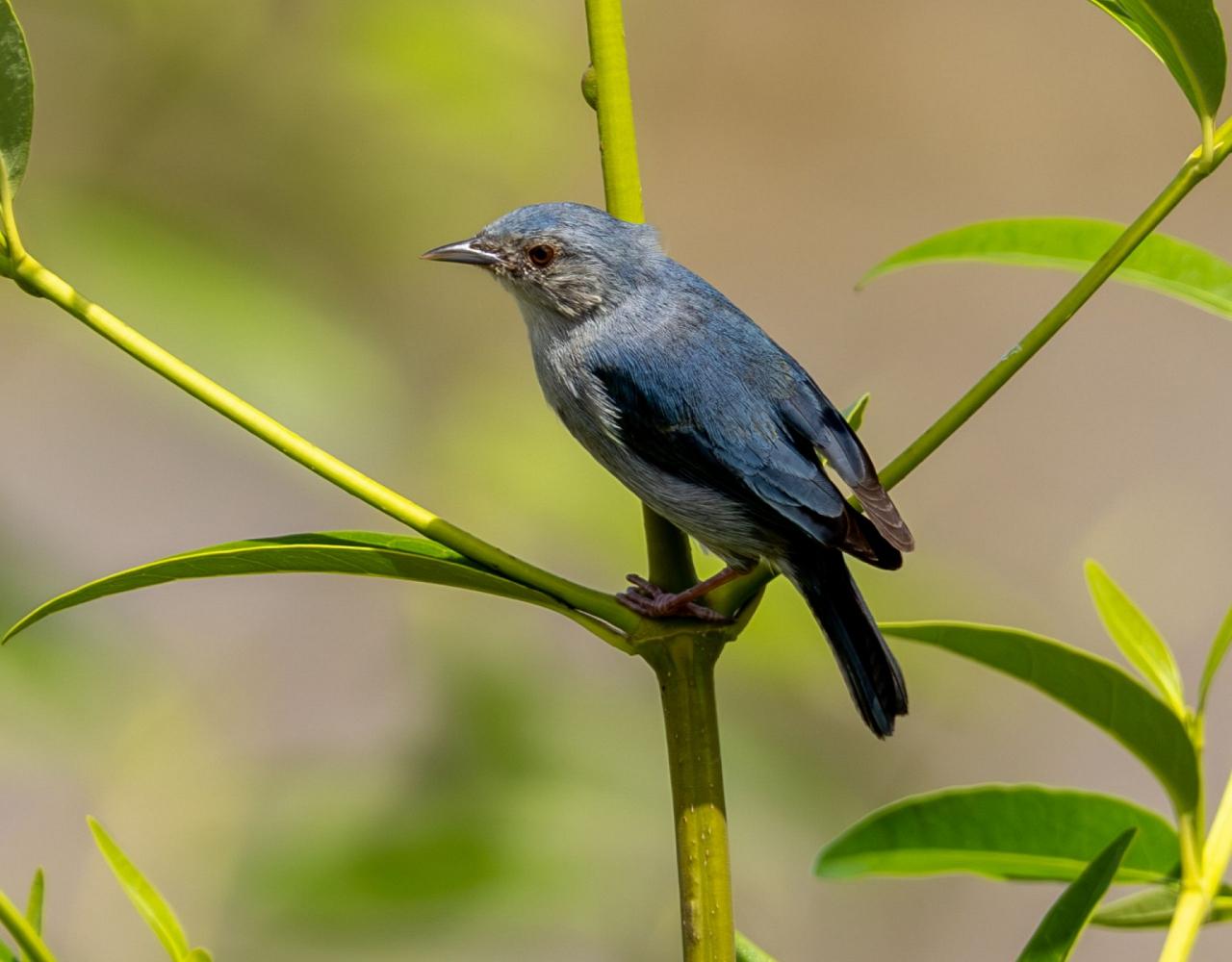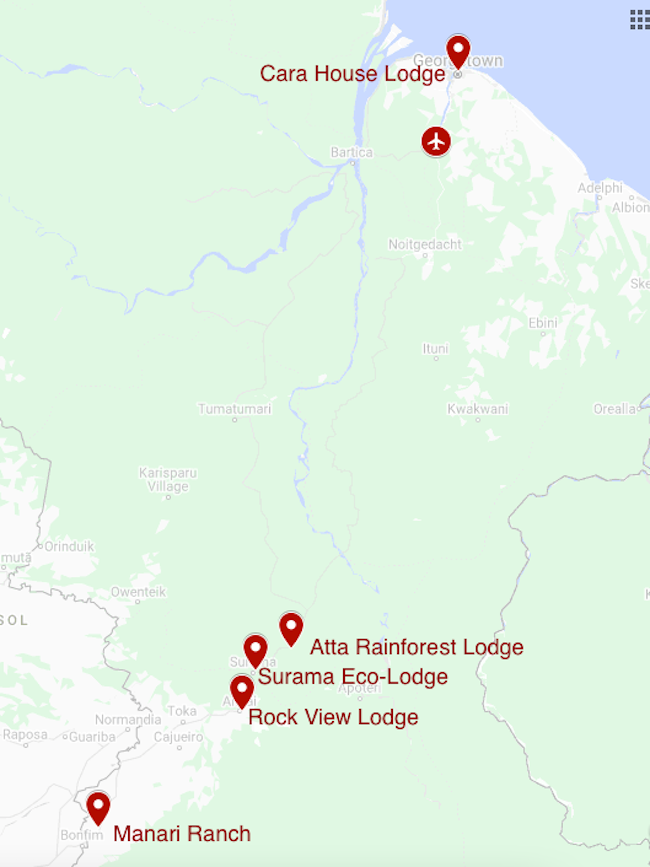- Overview
- Full Itinerary
- Photo Gallery
- Costing
- Travel Details
- Trip Reports
- Guide
- Map
- Know Before You Go
Join us on a fantastic adventure tour to Guyana, South America’s hidden gem. This unspoiled wilderness, off the radar for many of our travelers, offers an amazing experience — birds and mammals simply abound! The substrate here is the ancient granitic Guianan Shield, which, along with the Brazilian Shield to the south of the Amazon River, forms the primeval geologic heart of South America. Tropical rainforest has grown here for millions of years, slowly adapting to differing soil conditions as nutrients leached from the soils. Today Guyana still holds breathtaking and unending forest, myriad rivers, and expansive savannah. This Guyana nature tour also takes a bit of time to explore the vibrant, multi-cultural urban center at Georgetown, and its well-known botanic gardens.
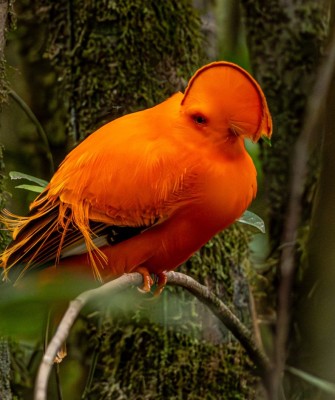
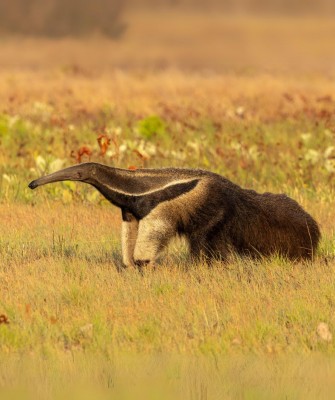
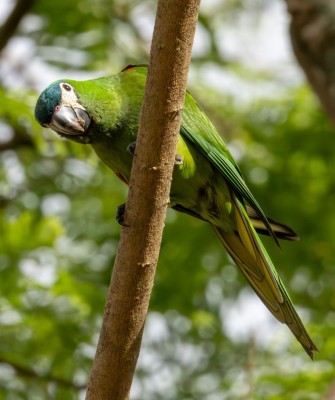
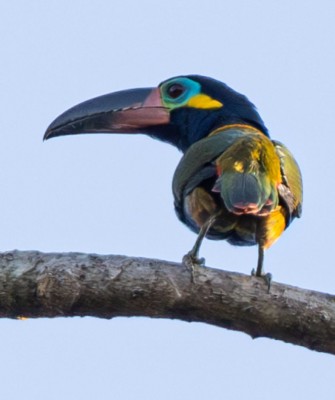
- “Destination and itinerary were far more astounding than I had imagined they could be. The number of amazing birds overwhelmed my memory banks. Every day there were fabulous birds, but the Rupununi River trip was a standout with the Sungrebe, the Rufescent Tiger-Heron, and the Sun Bittern, the Spotted Puffbird, and Green-tailed Jacamar. On and off the river that day we saw many parrot and macaw species. I was thrilled to see Jabiru and Maguari Storks.” — Jean Eaton, 2023 Traveler
- “It was an awesome trip. We saw some amazing birds, including my top 3 goal birds, Hoatzin, Cock-of-the-rock, and Scarlet Ibis. The two guides were fantastic. I always felt safe, the lodging was comfortable, and there was plenty of good food!” — 2023 Traveler
- “We had a 12-day birding adventure in Guyana that visited a wide variety of habitats and during which our group saw about 300 different species. We had excellent guides, great food, good accommodations, and felt we got great value for the cost.” — 2023 Traveler
- “The Kaieteur Falls were breathtaking, and we were fortunate to have good views of the amazing male Cock of the rock.. we were close to him, and he stayed around!” — 2023 Traveler
- “Guyana has a great variety of tropical habitats to visit and our tour did a good job of sampling them. From coastal rural to highland plateau to deep rain forest, riparian, and open savanna we hit them all. Our excellent in-country guide knew all the birds instantly. The two boat tours were fantastic! On each of them we saw many species and were close to the birds.” — 2023 Traveler
Tour Highlights
- Broaden your horizons and visit one of the few remaining untamed places on the planet
- See members of the odd cotinga family: brilliant Guianan Cock-of-the-rock, wine-and-white Pompadour Cotinga, and elfin Dusky Purpletuft … the birding here is incredible!
- Relax in cozy casitas at Surama Village ecolodge, where the Mukushi tribe are very proud of their ecotourism efforts
- Witness rare predators—six of South America’s elusive wild cats patrol the forests here
- Watch for the majestic Crimson Topaz Hummingbird, Red Howler Monkey, and Amazonian Motmot
- Float down a river in search of Giant Otter, Jabiru, up to five species of kingfisher, Harpy Eagle, and Green-tailed Jacamar
- Experience the jaw dropping Kaieteur Falls, travel with local expert guides, and find rare and iconic species
- Support locals who are extremely committed to conserving their forests and wildlife
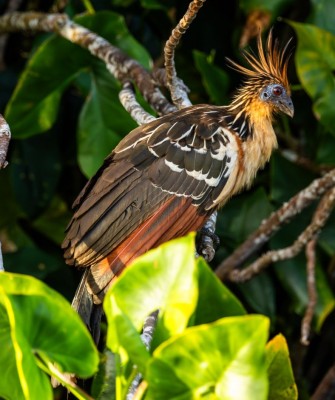
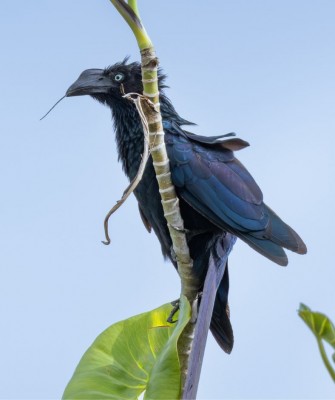
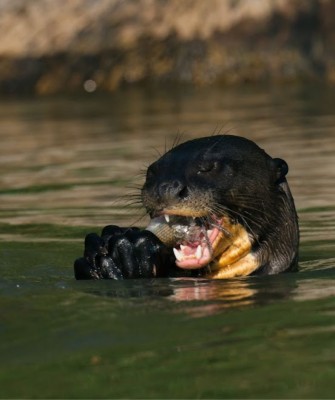
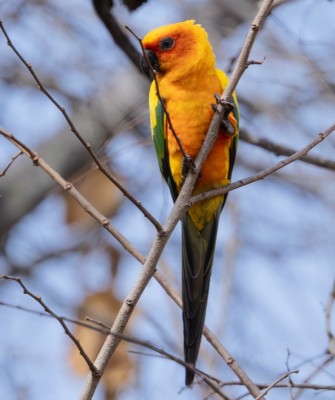
Trip Itinerary
Itineraries are guidelines; variations in itinerary may occur to account for weather, road conditions, closures, etc. and to maximize your experience.
Thurs., Mar. 12 Arrivals in Guyana | Georgetown
Arrive today at Cheddi Jagan International Airport on the outskirts of Georgetown, a coastal colonial city. Georgetown is a modern capital city and the chief port of Guyana. Along tropical, tree-lined streets, the city sports a fascinating mix of British, French, and Dutch colonial architecture.
Guests are met at the airport and transferred to the lovely Cara Lodge.
Cara Lodge is a bit of a splurge, and a long-standing tradition for our trips to Georgetown. Built in the 1840s and originally consisting of two houses, the hotel is one of the oldest wooden buildings in Georgetown. It has a long and romantic history … over the years it has hosted many dignitaries, including England’s King George V, who stayed at the house in 1923 and planted the sapodilla tree in the front garden to mark the occasion.
Please note: We have an early departure tomorrow morning. If you are considering a late-arriving flight, you may want to come in a day early to both enjoy this lovely hotel and to rest up from your travels. You will be met at the airport and transferred to the hotel regardless of which day you choose to arrive. Meals are at leisure today, those arriving in time for dinner can gather informally.
Accommodations at the delightful and relaxing Cara Lodge.
Fri., Mar. 13 Mahaica River in Search of Iconic Hoatzin | Botanic Garden
This morning, after coffee and tea service, we leave our hotel early to head eastward along the Atlantic coast, making a few stops along the way to check the mud flats for Scarlet Ibis as they set out to feed at dawn. We continue towards the community of Mahaica where we take a boat trip along the river. Among our targets is Guyana’s iconic national bird, the bizarre and primitive Hoatzin, which is found in abundance on this river system. We also look for a host of other species including the Rufous Crab Hawk, Black-collared Hawk, Black Hawk-Eagle, Long-winged Harrier, Barred Antshrike, Silvered Antbird, Striped Cuckoo, Little Cuckoo, Green-tailed Jacamar, Golden-spangled Piculet, Mangrove Rail, Mangrove Cuckoo, and a host of other interesting species. It’s wonderful to be on the water, but by mid-morning it is hot (thus the need for an early start). We return to the home of our local guide and boatman for an amazing and delicious full breakfast of Indian specialties—a field meal that you will not forget!
We then return to Georgetown for a rest, with stops along the way along the coast. Depending on the water level, we may be able to check the shoreline for Least, Semipalmated, and Western Sandpipers, Whimbrel, Black-belled and Semipalmated Plovers, Short-billed Dowitcher, Tricolored Heron, Yellow-crowned Night-Heron, Little Blue Heron, Magnificent Frigatebird, Royal, Gull-billed, and possibly Yellow-billed Tern, and Brown Pelican.
In the afternoon, after it cools down a bit, we visit the Georgetown Botanical Gardens, an area of parkland with open grass, scattered trees, bushes, and several ponds and wet areas. Raucous parrots and colorful macaws pass overhead as Wattled Jacana tread the lotus plants and water lilies. While the gardens are not elaborate, large trees provide habitat for the Guianas-endemic Blood-colored Woodpecker and other species such as White-bellied Piculet, the gorgeous Spotted Tody-Flycatcher, Rusty-margined Flycatcher, Southern Beardless- and Yellow Tyrannulet, Lesser Kiskadee, Black-capped Donacobius, Yellow Oriole, Yellow-chinned Spinetail, Wing-barred Seedeater, Straight-billed Woodcreeper, and plenty of Snail Kite. In the tree tops, we hope to see Red-shouldered Macaw, Orange-winged, Yellow-crowned, and Mealy Amazons, and with luck the Festive Amazon, a parrot species in serious decline due to the illegal pet trade. If the trees are flowering, we search for hummingbirds like Black-throated Mango and Glittering and White-bellied Emeralds. Coming and going to the gardens we see some of the city’s colonial architecture.
Accommodations at Cara Lodge, Georgetown (B,L,D)
Sat., Mar. 14 Off to the Wilds! Kaieteur Falls | Surama Village & Eco Lodge
After breakfast at our hotel, we drive to nearby Ogle Airport to take a chartered flight over unspoiled pristine forest to Kaieteur Falls, the world’s highest free-falling waterfall, impressive in its remote setting. Time permitting, we may stop at the coastal mudflats for one last chance at shorebirds, ducks, herons, and egrets. Though Venezuela’s Angel Falls is greater in total height, its filamentous drop occurs by stages, whereas Kaieteur is a single massive, thundering cascade up to 100 meters wide, created as the Potaro River makes a sheer drop of 228 meters—nearly five times the height of Niagara Falls. It’s quite possible that we are the only people viewing it, and pending good weather conditions, we land to see it up close, also viewing birds.
Near the falls, we hope to find White-chinned and White-tipped Swifts swirling over the gorge, and perhaps we are lucky enough to spot Orange-breasted Falcon hunting for its favorite prey, the swifts. There is also a Guianan Cock-of-the-rock lek here, so we have a good chance at our first look at this brilliant species. Along the trail, look carefully to find the rare Golden Rocket Frog that lives in water held in the giant tank bromeliads.
We spend about two hours at the falls, then our flight continues to Surama Village airstrip from which we are driven to Surama Eco Lodge in the heart of Guyana’s beautiful savannah and rainforest. We arrive in time for a late lunch before birding the trails around the lodge and visiting a nearby Great Potoo roost. At dusk we look for Lesser and Least Nighthawks, White-tailed Nightjar, and a few owls.
Tonight, we settle into our simple but comfortable casitas with private bath and open-air ventilation through large windows; mosquito netting keeps you comfortable in your bed. Views overlook the savannah to the encircling mountains — stunning. Meals feature local foods prepared by a well-trained culinary staff … a treat so far out in the wilds!
Accommodations at Surama Eco-Lodge (B,L,D)
Sun., Mar. 15 Surama Eco-Lodge | Harpy Eagle Trail | Village Life
Don’t be surprised if you are awakened by the dawn calls of Spectacled Owl or Slaty-backed Forest-Falcon and Little Chachalaca. No matter, as we are up early to bird, then take a short drive to the Harpy Eagle trailhead. This trail winds its way through beautiful primary forest where Red-and-black Grosbeak, Golden-sided Euphonia, Orange-breasted Falcon, Blue-and-yellow and Scarlet Macaws, Ornate Hawk-Eagle, Cream-colored Woodpecker, Yellow-billed Jacamar, Tiny Tyrant-Manakin, Cinnamon Attila, Black-headed Antbird, Amazonian Antshrike, Ferruginous Antbird, Rufous-winged Ground Cuckoo, and possibly Guianan White-faced Saki Monkey reside. We arrive at the view point where in some years, a Harpy Eagle pair is attending their nest; they are always in the area, here and near the river corridor. We can hope that they are present today!
Back in the village we learn about community conservation efforts. Visit the local school and perhaps the community building for the Guyana Wildlife Club. It was here in the pastoral setting of mountain and savannah that Charles Waterton passed through in 1812. He journeyed in search of the secrets of the useful Wourali poison known as Curare. Waterton was so impressed by this spot that he wrote in his memoirs, “The finest park that England boasts falls short of this delightful scene.”
Surama’s inhabitants are mainly from the Macushi tribe and still observe many of the traditional practices. Our guide takes us on a village tour, an experience most find far more enjoyable than they expect — it’s inspirational how the local people relate to nature and how they see their place in this modern world. We visit the local school, medical center, and church, along with some of the village houses.
As the afternoon cools, a local guide shares knowledge of nature and birding on trails to seek out resident mammal and bird life. See the forest through the eyes of your indigenous guide and learn about the medicinal plants and their uses in the Amerindian culture. The whole experience here is unique.
Tonight we enjoy another walk to observe wildlife and experience the mystique of the forest after dark. We hope to locate Tawny-bellied Screech-Owl, Black-banded Owl, as well as Tropical Screech-Owl, Lesser Nighthawk, White-tailed Nightjar, and both Great and Common Potoos.
Accommodations at Surama Eco-Lodge (B,L,D)
Mon., Mar. 16 Surama Eco Lodge | Burro Burro River
Morning here is a treat … imagine waking so close to the wilds. However, just a step away is fresh coffee and breakfast.
During our stay here, we hope to encounter Red-legged Tinamou, Painted Parakeet, Dusky Parrot, Lilac-tailed Parrotlet, Pale-tailed Barbthroat, Rufous-throated Sapphire, Great and Paradise Jacamars, Black-spotted Barbet, Golden-spangled Piculet, and Chestnut-rumped Woodcreeper. The South American clan of antbirds is well-represented here—we look for Northern Slaty-Antshrike, Rufous-bellied, Spot-tailed, and Todd’s Antwrens, Dusky, White-browed, White-bellied, Ferruginous-backed, Rufous-throated, and Guianan Warbling Antbirds, and other birds including Helmeted Pygmy-Tyrant, Lemon-chested and Ashy-headed Greenlets, and Finsch’s Euphonia. Hopefully it won’t be too long before our attention is drawn to the far-carrying, growling song of the bizarre, social lek displaying Capuchinbird. The skilled local guides sometimes know of the territories of these canopy-dwelling birds, their bald heads and strange hump-shouldered appearance an unforgettable sight if we are lucky enough to spot them.
To find all these gems, we might choose to explore the surrounding habitats on trails, or we can venture out in small boats on the Burro Burro River for a quiet and skillfully-guided paddle, hearing the voices of many birds singing, and with luck coming down to the shore. We also search the banks for mammals like Giant River Otter, Tapir, Tayra, Black Spider Monkey, and more. The Burro Burro River trail is known for reliable sightings of Cream-colored Woodpecker, Rufous-winged Ground Cuckoo, Red-legged Tinamou, Guianan Puffbird, Fiery-tailed Awlbill, and Blue-throated Piping-Guan. We count ourselves extremely fortunate if we succeed in getting good looks at some of these more elusive species.
Back in the village, the dining room’s upstairs bar boasts views all around (as well as cold sodas and beer). Local crafts and artwork are displayed here as well. We gather here ahead of dinner to recap our bird list, enjoy the sunset and each other’s company.
Accommodation at Surama Eco-Lodge (B,L,D)
Tues., Mar. 17 Atta Rainforest Lodge | Canopy Walkway | Iwokrama Forest
This morning we depart Surama to head to nearby Atta Rainforest Lodge where we spend the next two nights surrounded by pure nature, with no sounds but the noise of the forest. But first, en route, we walk a trail to a Guianan Cock-of-the-rock lek where we hope to have another opportunity to see this beautiful bird as it displays ahead of nesting. We then continue on to Atta for lunch and a well-deserved cold beer or cold drink of your choice.
After a rest, we spend the afternoon birding on the main road through the Iwokrama Forest, just a short distance away. The road has little traffic and makes an ideal place for us to wander at a birder’s pace. The trees are impressive, their height deceiving as we sort through mixed flocks. Thankfully a number of large, loud, and colorful species exist here, including several species of parrots and macaws. We look for Spangled Cotinga, as well as Blue-backed Tanager, Swallow-wing, Black-chinned, Scale-backed, and Gray Antbird, Guianan Streaked Antwren, Amazonian and Mouse-colored Antshrike, Reddish Hermit, Tiny Tyrant Manakin, Rose-breasted Chat, Black and Red-throated Caracara, Violaceous Trogon, Golden-winged Parrot, and Yellow-green Grosbeak. While birding along the road, we also keep watch for the elusive Jaguar and Tapir, which are difficult to find but most possible to see at dawn and dusk.
Beside a small wetland we could find Dwarf Caiman, Uniform, Ash-throated, and Russet-crowned Crakes, and Zigzag Heron — all of which are difficult. This is a good night birding route, and there are possibilities for White-winged, Rufous, Great, Common, and Long-tailed Potoos, plus Spectacled and Crested Owl.
Accommodations at Atta Rainforest Lodge (B,L,D)
Wed., Mar. 18 Atta Rainforest Lodge | Canopy Walkway
At dawn, we visit the canopy walkway to look for passing flocks of canopy-dwelling species. Time is spent looking for Todd’s Antwren, Spot-tailed Antwren, Short-tailed Pygmy-Tyrant, Guianan Toucanet, Green Aracari, Painted Parakeet, Screaming Piha, Black-headed Parrot, Guianan Puffbird, Dusky Purpletuft, Paradise Tanager, Opal-rumped Tanager, Golden-sided Euphonia, Purple and Green Honeycreepers, Black-faced Dacnis, and Black Nunbird. The rest of the morning we spend on the grounds, taking in all we can see.
The grounds of Atta Rainforest Lodge are wonderful and support some great post-lunch leisurely birding. This wonderful area is famed for its variety of colorful cotingas and if we can locate a few fruiting trees we are in for an avian spectacle with possibilities of Pompadour, Spangled, Purple-breasted, and Guianan Red-Cotinga, as well as White Bellbird. Within the forest that surrounds the lodge we can look for Red-legged and Variegated Tinamous, Gray-winged Trumpeter, Cayenne Jay, Amazonian Barred Woodcreeper, Red-billed Woodcreeper, Helmeted Pygmy-Tyrant, Ferruginous-backed Antbird, Waved, Chestnut, and Red-necked Woodpeckers, as well as Black Spider Monkey and White-faced Saki Monkey.
This is one of the best places to see another of Guyana’s “must see” birds: the outrageous Crimson Fruitcrow. This species is seen here on a reasonably regular basis; it often comes to feed in nearby trees. The clearing is also a reliable site for Black Curassow — there is a family party that has become habituated to people and regularly passes by. With reasonable luck, we should be able to add this bird to the impressive list of species we hope to see around the lodge and walkway. Few places in the world rival this experience, with nature so abundant and right outside the door.
A 20-minute walk along a very good trail takes us to Atta's celebrated Canopy Walkway. The trail leads partially up a steep hillside, and from it we step onto a series of suspended walkways and decks, each anchored to a giant rainforest tree. This nearly-level system of walkways carries us to vantage points up to 35 meters high, which overlook the surrounding canopy. From these decks, we train our binoculars and scope on any wildlife we find. Among the 134 bird species recorded at the walkway are Painted Parakeet, Rufous-throated Sapphire, Guianan Puffbird, Green Aracari, Waved Woodpecker, Pygmy Antwren, Guianan Streaked-Antwren, Dusky Purpletuft, Purple-breasted Cotinga, Guianan Toucanet, Pompadour Cotinga, Buff-cheeked Greenlet, Caica Parrot, and a host of other canopy specialists. From this treetop vantage you can sometimes see Red Howler Monkey and Black Spider Monkey, too.
Accommodations at Atta Rainforest Lodge (B,L,D)
Thurs., Mar. 19 White Sand Forest
This morning, we take a short drive to a unique white sand forest patch near the lodge. This area supports a variety of species including Saffron-crested Tyrant-Manakin, Bronzy Jacamar, Olivaceous Schiffornis, Ringed Woodpecker, and the recently found Pelzeln’s Tody-Tyrant. This is also one of the best areas to see Gray-winged Trumpeters as they forage on the forest floor. We spend our time walking through this impressive forest most of the morning.
After lunch at the lodge, we spend time exploring the access road to search for the striking Crimson Topaz, the handsome Guianan Toucanet, Green Aracari, Scarlet Macaw, Marail Guan, and many others. At dusk we look for Short-tailed Nighthawk, Common and Long-tailed Potoo, and a variety of owls.
Accommodations at Atta Rainforest Lodge (B,L,D)
Fri., Mar. 20 Across the Rupununi Savannah in Search of Sun Parakeet
Our day begins early as we say goodbye to Atta Lodge and head out for our next stop, Manari Ranch Lodge. After a very early breakfast, we head to Karasabai, an Amerindian village in the foothills of the Pakaraima Mountains, where the astonishingly beautiful Sun Parakeet is found. This area is a good example of a bird conservation project hosted by a local community. Once almost wiped-out of the region by intense trapping for the pet trade, the population of the parakeet has begun to rebound under the protection of the Karasabai community. We plan to spend some time learning from the local community about this successful conservation program. We also look for the distinctive subspecies of White-bellied Piculet and Yellow-hooded Blackbird, which may soon be elevated to full species status. Hooded Siskin, Toco Toucan, and Ferruginous Pygmy-Owl are also present. After lunch at the community hall, we bird our way back across the savannas to Manari Ranch, near the outskirts of Lethem, looking for open country birds including Aplomado Falcon, Pearl Kite, White-tailed Hawk, Double-striped Thick-Knee, Maguari Stork, Azure Gallinule, and Jabiru. As we arrive to the comfort of Manari Ranch, we make time to relax and enjoy an early dinner. At dusk we watch the skies for Lesser, Least, and Nacunda Nighthawks leaving their roosting sites for their foraging grounds.
Accommodations at Manari Ranch (B,L,D)
Sat., Mar. 21 Takatu & Ireng Rivers | Gallery Forest
Our last day in the field again finds us on the road before dawn, driving to a dry scrub forest along the Takutu and Ireng Rivers, which form Guyana’s southwestern boundary with Brazil. We spend much of our time looking for two poorly known, very local, and endemic species: Hoary-throated Spinetail and Rio Branco Antbird. Another possibility is the spritely Chestnut-vented Conebill, which travels in small but active groups through the riverine forest. We also look for Crestless Curassow (a species that can be difficult to locate), Pearl Kite, Aplomado Falcon, Rufous-tailed Jacamar, White-throated Kingbird, and Flavescent Warbler. Lunch is back at Manari Ranch. During the afternoon, we spend time birding near the environs of the ranch. At the end of the day, we enjoy a cool drink in the breezeway of the ranch while admiring the coming and going of Orange-backed Troupial, Brown-throated Parakeet, and Red-shouldered Macaw in the giant mango trees nearby.
Accommodations at Manari Ranch (B,L,D)
Sun., Mar. 22 Moco Moco Village | Afternoon Birding
After breakfast, we have a 30-minute drive to Moco Moco Village. A tributary of the Takutu River runs through the village, which is named after the Moco Moco plant found along the banks. We spend time birding in this unique habitat and search for White Bellbird, Amazonian Motmot, Fasciated Tiger-Heron, Sungrebe, and many hummingbirds including Copper-tailed Hummingbird, Streak-throated Hermit, and Ruby Topaz. There is also an active Guianan Cock-of-the-Rock lek here and we make a stop to check on activity.
We return to the lodge for lunch and later in the afternoon we head back out to some nearby oxbow lakes. Here, we look for Collared Plover, Azure Gallinule, Pinnated Bittern, and if we are lucky, Masked Duck.
Accommodations at Manari Ranch (B,L,D)
Mon., Mar. 23 Manari Ranch | Fly to Georgetown
Our final morning we enjoy an early breakfast and then spend time birding and exploring near Manari Creek, where Giant River Otter are possible, as well as Giant Anteater. Our time of departure depends on the timing of the flight schedule, but there is plenty of time to pack and clean up during the early morning.
We then depart Lethem on the afternoon flight back to Georgetown’s Ogle International Airport on a scheduled flight that takes about 90 minutes. Soak in the vast expanse of green, Guyana’s tropical rainforest.
We have a chance to clean up, enjoy the luxury of air-conditioned rooms, and a final dinner at our hotel in Georgetown. Dinner is at your leisure tonight since your guide does not travel back with you to Georgetown. There is someone to meet you at the airport, however, and you can order drinks and dinner as you wish — on your own or joining others from the group, and pay with credit card at the end of your stay.
Accommodations at Cara Lodge Hotel (B,L)
Tues., Mar. 24 Departures from Georgetown
Today you depart Guyana. We arrange to transfer you to the airport in good time for your check in time and departure.
Cost of the Journey
Cost of the 13-day journey is per person, based on occupancy: $7590 DBL / $7890 SGL, from Georgetown. The cost includes meals as specified in the itinerary (see Georgetown days), group airport transfers, in-country transport including flights, professional guide services including local guides, park and program entrance fees, and miscellaneous expenses.
NEW! all tips other than your NJ guide (optional) and local guide are included (this includes tips for your driver, lodge and staff, day activities, meals and other services).
Tour cost does not include: round-trip transportation from your home city to Georgetown, Guyana, optional activities, or items of a personal nature such as laundry, telephone charges, or beverages from the bar.
Travel Details
Please plan to make air travel plans only after the minimum group size has been met. We will send you a confirmation email as soon as the trip has been confirmed.
Arrival and Departure Airport: Cheddi Jagan International Airport (GEO)
Arrival Details: March 12, 2026 at your leisure (a time convenient for you)
Departure Details: March 24, 2026 at your leisure (a time convenient for you)
Travel Tips: Note the airport is about an hour drive from our hotel in Georgetown, so if you arrive late, clear immigration and customs, it can be several hours until you check in. Therefore, if you use the late arriving flights, we encourage you to come in a night early to rest up and recalibrate your time clock. We can book you an early night at the Cara Lodge, or it is easy to book online yourself at https://www.caralodge.com.
We do host an optional arrival day afternoon field trip to some local birding sites for those that arrive in time, and a welcome dinner. On the hind end, we fly back from Lethem, arriving in the afternoon with plans to overnight at Cara Lodge. You may fly out that evening, remember you need to check in 2.5-3 hours ahead and have an hour’s drive to the airport, but you can make those later flights. We will leave your hotel room in place for you to shower, freshen up and repack – pretty necessary in this hot climate!
Entry Requirements: See "Essential Information" section under the "Know Before You Go” tab.
Items of Note
This trip is very demanding and not a good choice for those with physical limitations or who are elderly; our tour visits remote locations with little or no medical care available. This is an adventurous tour, and includes travel to remote locations with rustic accommodations. Lodges don't typically have fans, and mosquitoes can be intense. Heat and humidity can be brutal and our days are very hot and dusty. Participants should be able to walk on uneven terrain up to 3 miles. We plan to rest during the hottest hours of most days.
A flexible attitude and sense of adventure is always appreciated by the group. Guyana is still on the frontier of ecotourism and there may be some adventures! We think it’s well worth it to explore some of the most fabulous tropical forests on the planet, and we balance that with the lovely Cara Lodge in Georgetown at the start and end of the tour.
Browse below for trip reports and species lists from past versions of this and other tours from this destination.
Guyana
- October 2015
- February 2016
- February 2018
- March 2019
- January 2020
- February 2020
- October 2021
- February 2022
- October 2022
- February 2023
- March 2023
- October 2023
- February 2024
- March 2024
- October 2024
- March 2025
-
Dominic Mitchell

A birder for more than half a century and a committed conservationist with a wide-ranging interest in nature, Dominic founded the leading UK magazine Birdwatch, ran it for 27 years, and was also Managing Editor of BirdGuides.com for six years. He has led tour groups to many exciting destinations around the world over the past 25 years, with field experience in more than 80 countries and territories across all seven continents. A leading UK eBirder, reviewer and hotspot editor, Dominic is one of the few to have seen more than 800 species in his home region of the Western Palearctic. He has served on the Portuguese Rarities Committee and the Council of the Ornithological Society of the Middle East, and has worked as Ornithologist on an expedition cruise ship. His books on birds include the well-received Birds of Europe, North Africa and the Middle East, published by Lynx Edicions in 2017, and he is currently Editor-in-Chief at BirdLife International, the world’s largest conservation partnership. He is married with two children and a Romanian rescue dog, and divides his time between Norfolk and London, where his long-term study of a local landfill led to him discovering Britain’s first (and only) Slaty-backed Gull.
Other trips with Dominic Mitchell
Essential Information +
Pace & Protocols +
Packing List +
Suggested Reading List +
Useful Links +
Photo credits: BANNERS: Giant Anteater (Mason Flint), Common Tody-Flycatcher (Mason Flint), White-throated Toucan (Mason Flint), Orange-backed Troupial (Mason Flint) THUMBNAILS: Guianan Cock-of-the-Rock (Mason Flint), Giant Anteater (Mason Flint), Red-shouldered Macaw (Mason Flint), Guianan Toucanet (Mason Flint), Hoatzin (Mason Flint), Greater Ani (Mason Flint), Giant River Otter (Wes Larson), Sun Parakeet (Mason Flint)





